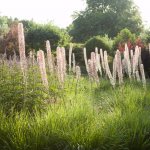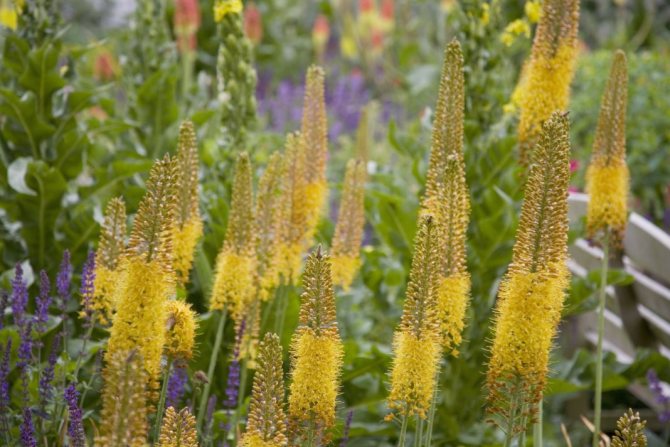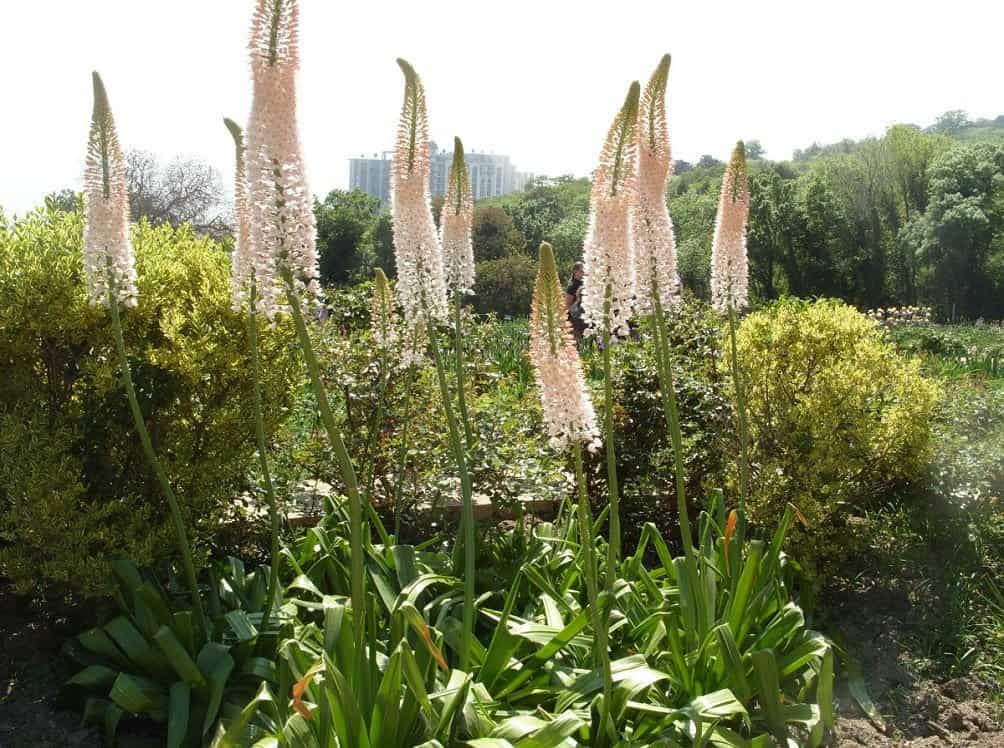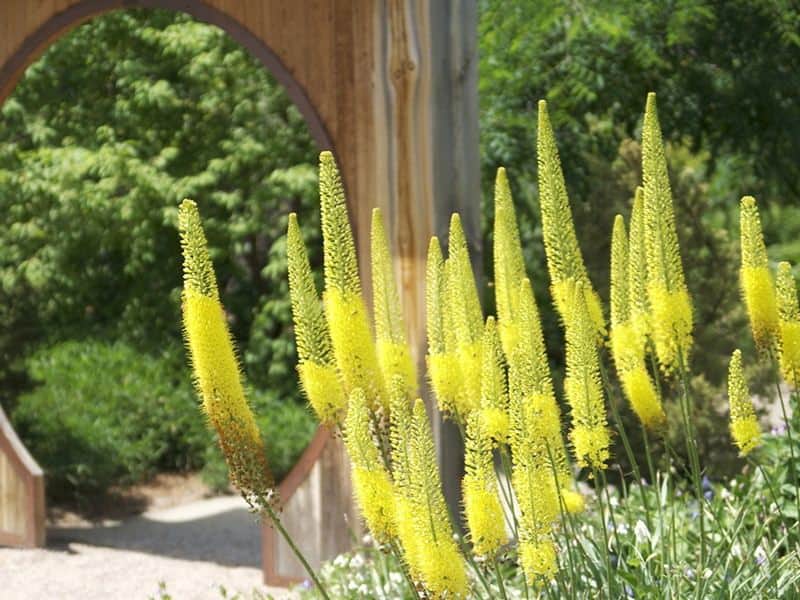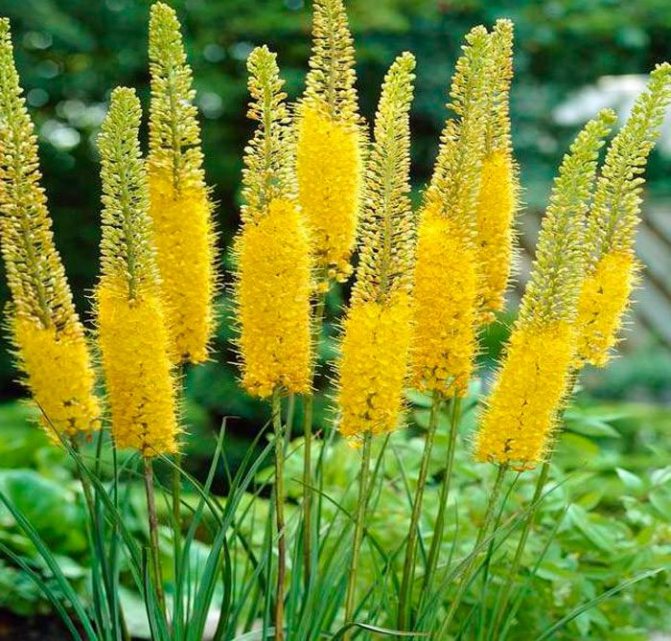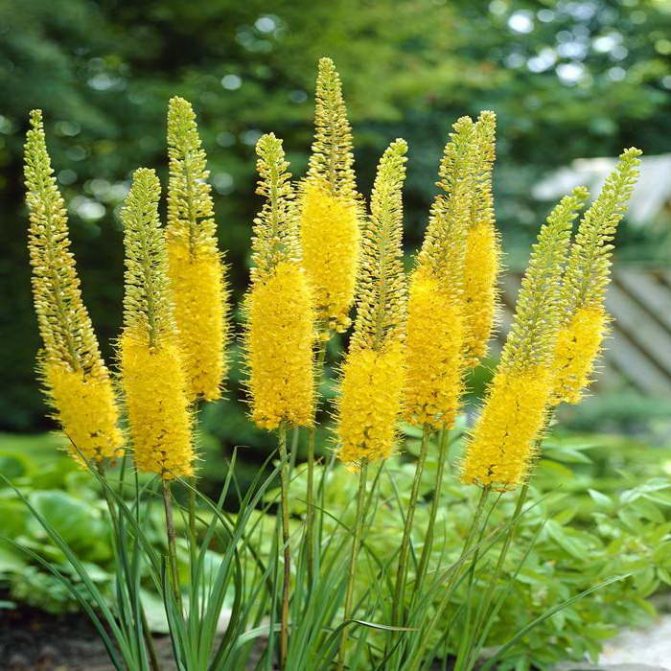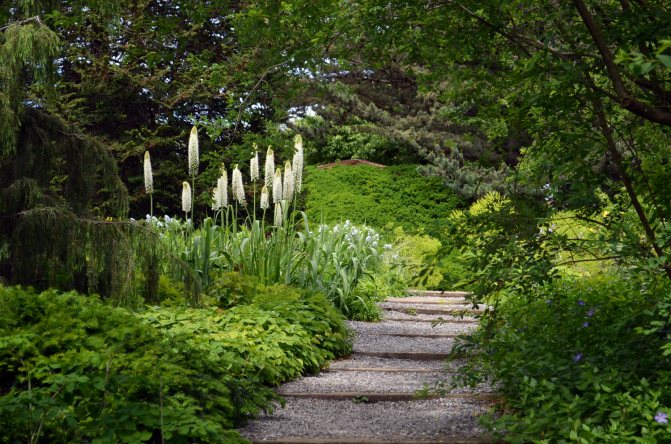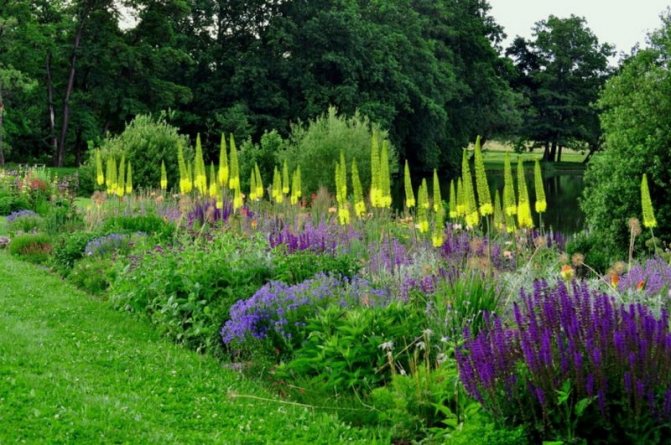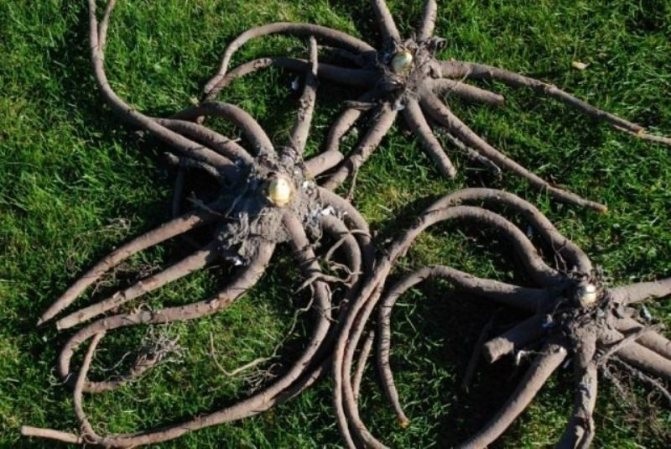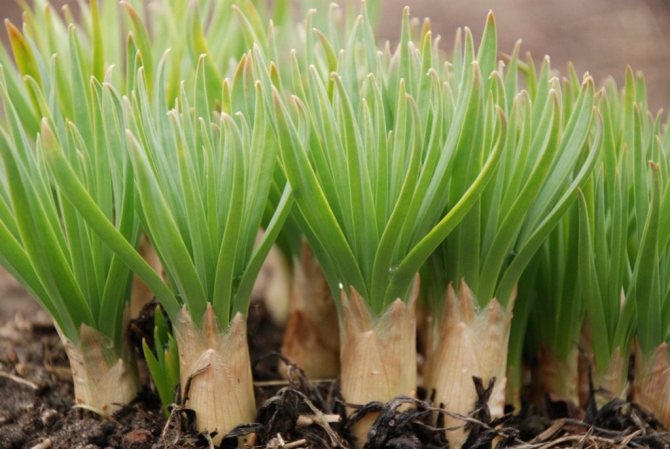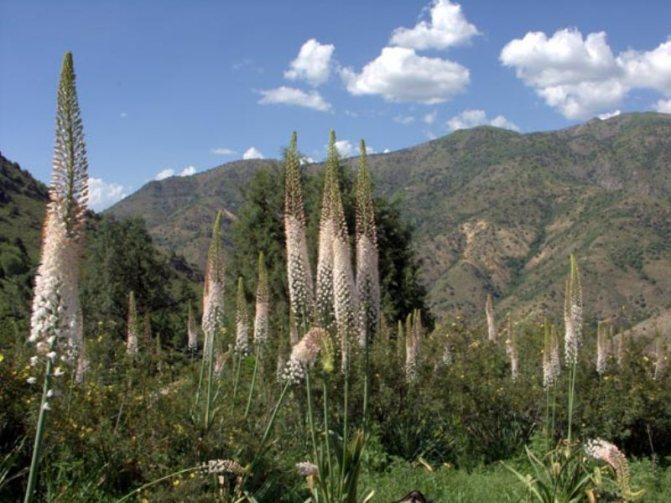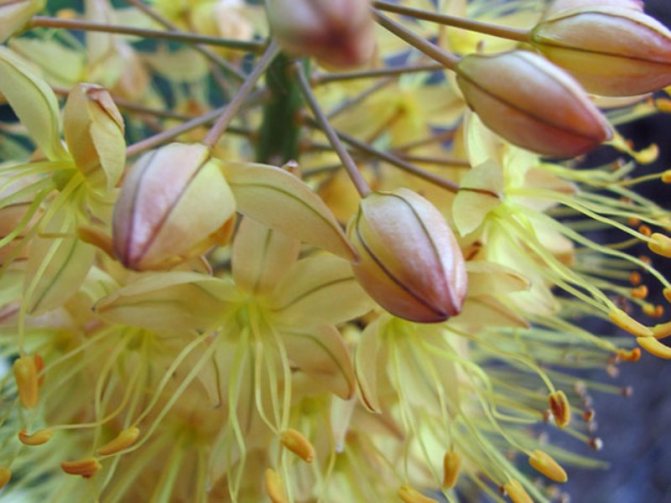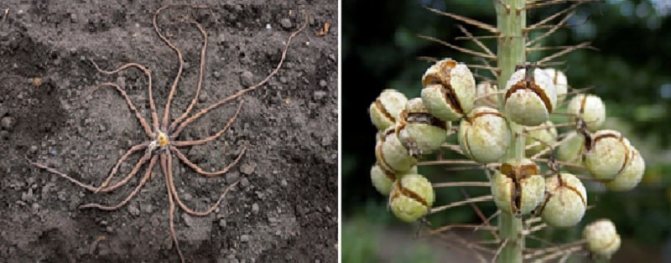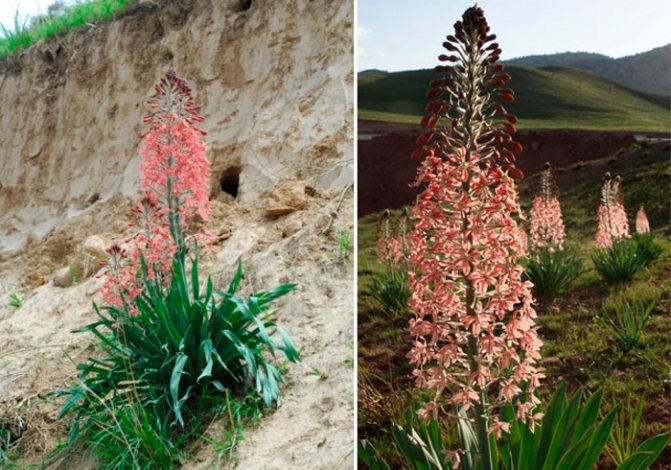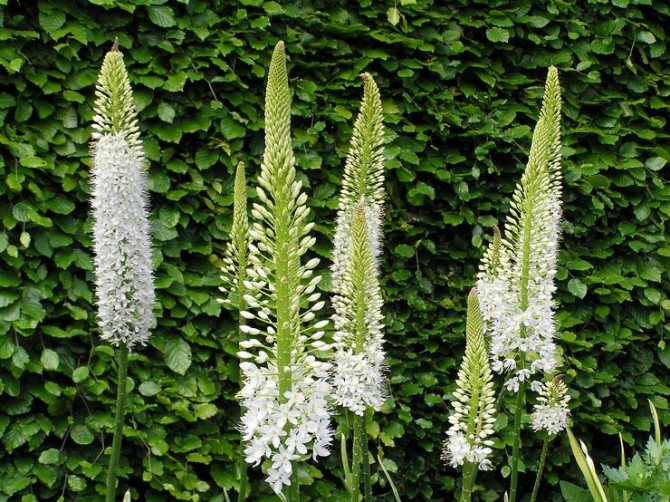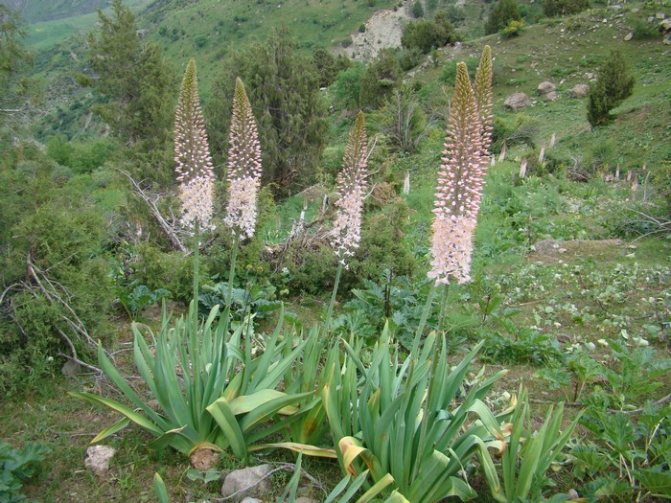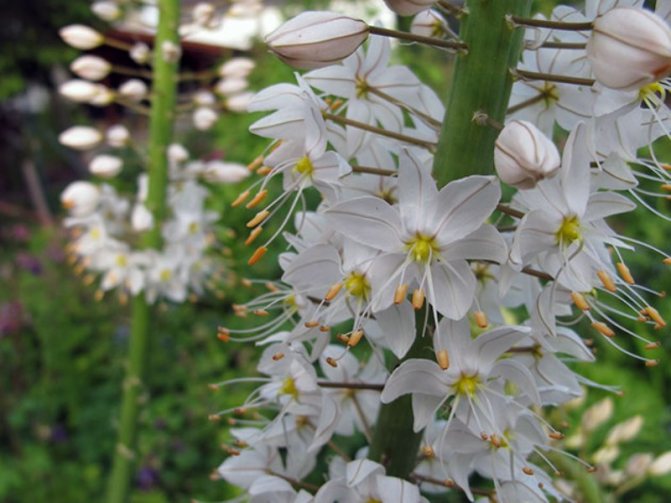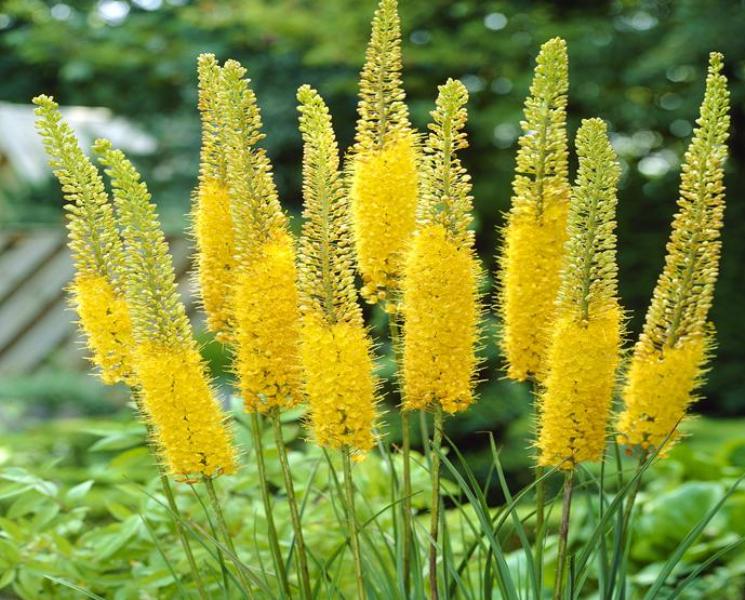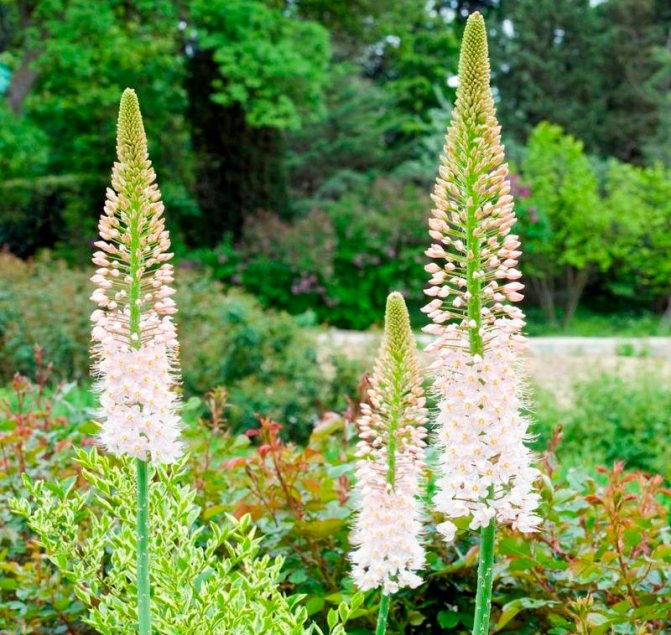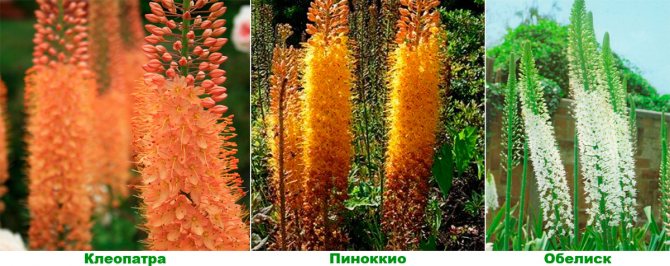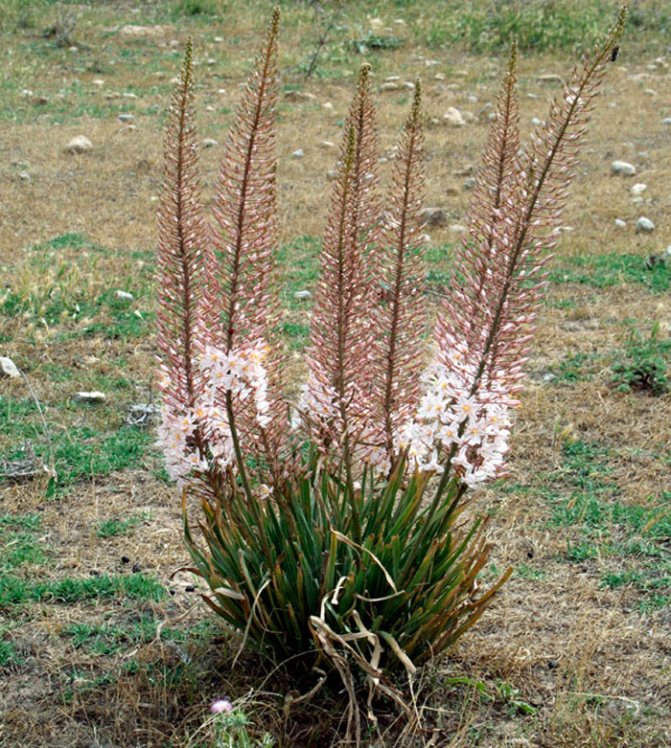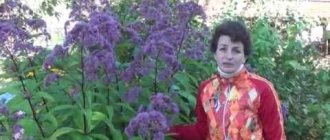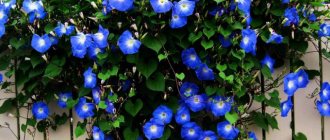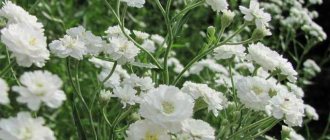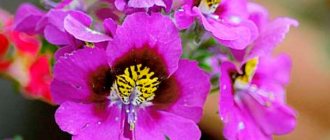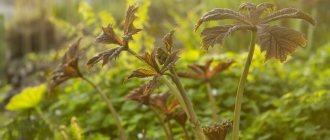The herbaceous perennial plant Eremurus, also called shrysh, or shiryash, is a representative of the subfamily of the asphodelic family of the Xanthorrhea family. This genus unites more than 40 species, hybrids and varieties. The name of such a flower is derived from two Greek words, which in translation mean "desert" and "tail". Looking at the dense, tall peduncles, one can immediately understand why people who lived in ancient civilization named such a plant exactly Eremurus. For people living in Central Asia, the words shrysh and shiryash mean glue, the fact is that in these places, technical glue is obtained from the roots of such a flower. A plaster is made from the dried and powdered roots. If the roots are boiled, then they can be eaten, while they taste similar to asparagus, and they also eat leaf plates of some (not all!) Species. Any part of such a plant can be used to color the natural fiber yellow. Eremurus was first described in 1773 by the Russian traveler, geographer and naturalist P. Pallas. They began to grow these flowers in the botanical gardens of Western Europe and Russia already in the sixties of the 19th century, more than half a century later the first hybrid was born, while breeders do not stop working with Eremurus to this day.
Desert luxury of incomparable inflorescences
The botanical name Eremurus received in honor of its long, luxurious, especially spectacular looking in a desert area, even from a considerable distance of long inflorescences (from the Greek "eremos" and "ura" - "desert tail"). The popular names for Eremurus are much less poetic than its official name. Shiryash or Shrish comes from the Tajik and Kazakh words for "glue", indicating the unique properties of the sticky substances contained in the roots. Despite the fact that eremurus is an edible plant (young roots and leaves of some species are eaten as a vegetable), as well as a source of natural yellow ocher dyes, it is considered primarily as an ornamental plant. The majestic beauty of the fluffy huge verticals of the inflorescences gave him an equally beautiful nickname - Cleopatra's needle.
Eremurus are powerful herbaceous perennials that form a very large rhizome. Fusiform, tuberous, thickened cornedonian eremurus with buds on the upper side is difficult to confuse with any other garden plant. Their maximum diameter reaches 15 cm.In addition to the Cornedonian, the Eremurus also forms a powerful system of feeding fusiform or cord-like thick roots (up to 30 pieces), extending almost horizontally from the bottom, and a network of thin feeding long roots (thickened roots - up to 15 cm in length, thin - up to 1 m). When sold, especially for imported plants, the roots are often shortened, but then the plant grows a full-fledged root system. The Cornedonce constantly grows upward, the lower part with old roots dies off annually after a period of summer dormancy, and new storage roots grow in the upper part.
The plant forms dense "bundles" of root leaves collected in rosettes.Long and linear, very beautiful, triangular or keeled, the leaves of the plant look great in any decorative composition, immediately giving the impression of an exotic and bright plant. Erect leaves, as if fanning out from the center of the bush with strongly pointed tips, add graphicality and rigor to the plant.
Eremurus develop in a rather specific way: in the summer they have a "habit" inherited from their wild ancestors, the summer period of dormancy begins, during which the aerial part dies off completely or partially. In the fall, not all species wake up, some eremurus form buds and roots in the spring, and in the fall they completely leave the garden scene until the next season.
The status of a flowering plant in Eremurus is undeniable. Despite the rather attractive foliage, Eremurus are prized primarily for their flowering. Huge, half a meter or more, openwork cylinders on a slender peduncle of this culture are the largest and most catchy of all horticultural crops with a similar elongated type of candle-shaped inflorescences.
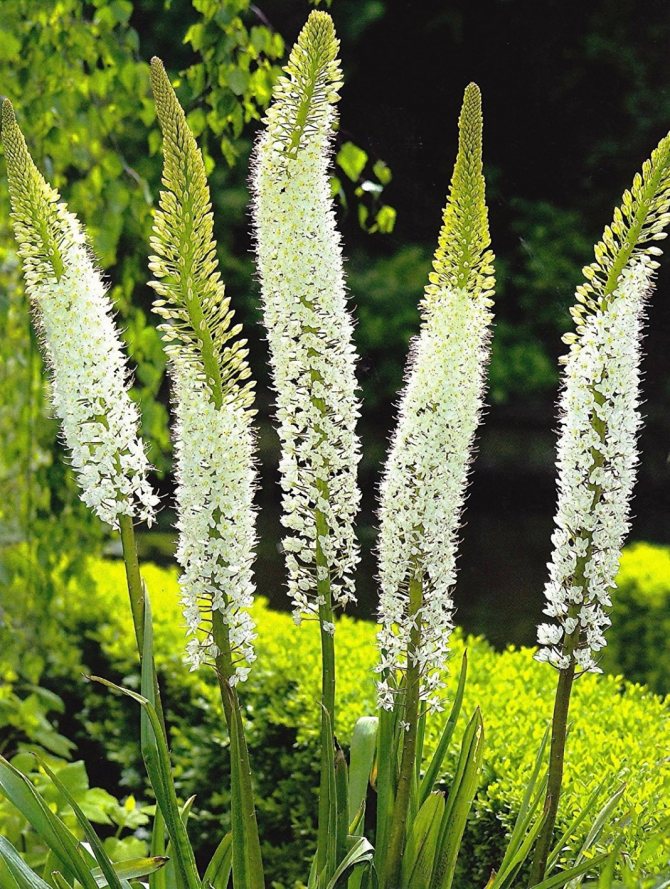
Eremurus himalaicus (Eremurus himalaicus)
Eremurus inflorescences-sultans are able to enchant with their fluffy effect, bright colors and tenderness. Tall, elongated, conical or cylindrical inflorescences are crowned with straight peduncles up to almost 2 m high, effectively towering over a rosette of beautiful leaves. Eremurus peduncles are very simple and strong, most often they are quite thin. The shape and beauty of individual flowers can be seen only close, but the elongated cylindrical inflorescence - an erect brush - can be seen even at a very great distance. The length of the inflorescences ranges from 15 cm to almost 1 m.
The flowers in the raceme are arranged in a spiral, on short or elongated pedicels. Flowers in all Eremurus are bell-shaped, in most they are wide open, with a large and catchy, most often lanceolate or triangular bracts. The flower flaunts with a graceful perianth with six leaves decorated with colored veins, which outwardly seem to be typical petals, and six stamens with thin filaments and swinging anthers. Most often, filaments are longer than the perianth. In the buds, the pedicels are almost pressed against the axis of the inflorescence, gradually protruding, which, in combination with the long stamens, gives the cylinders of the inflorescence an openwork fluffiness and a feeling of living lace.
Flowers bloom from the bottom up, a wave of flowering rises along a tall peduncle, as if the widest and brightest area is gradually rising in a spiral. At the same time, up to 10 flowers bloom in Eremurus, the number of flowers in one inflorescence ranges from several tens to a thousand.
The color palette of Eremurus includes white, pink, yellow, cream and brown in delicate pastel variations and bright acrylic shades of the “warm” part of the color spectrum in hybrid varieties.
Traditionally, Eremurus bloom in the first half of summer, delighting with gradually opening flowers in inflorescences in June and July. Some species are capable of blooming in spring, in April-May. The earliest flowering variety of Eremurus is the Himalayan Eremurus, but earlier than the main species, the narrow-leaved Eremurus also blooms. Flowering lasts from just over one week to 40 days.
After flowering, Eremurus tied dry, rounded tricuspid capsules of fruits, hiding wrinkled winged triangular seeds.
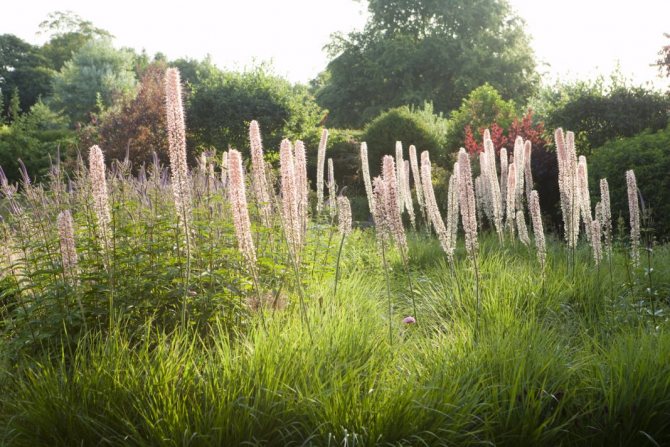

Eremurus x isabellinus ‘Romance’
Description of the eremurus flower
Literally translated from Greek, Eremurus means "the tail of the desert." If you look at a flower, you will immediately understand why it has exactly such a name. There are also secondary names shiryash and shrysh, they are given to the flower because glue is extracted from its roots.
The root system of the eremurus resembles a starfish in shape, small roots extend from the main root so that a shape is obtained that is very much like a star. The bush has no main stem. Leaves and stems grow straight from the roots and form a rosette. The flower is elongated and lush, it consists of more than one hundred small flowers that look like bells.
Types and varieties of Eremurus
Genus Eremurus (Eremurus) is very large and includes more than six dozen separate species, although some of them are actively revised and combined today, constantly including other similar crops in different sections of the Eremurus genus, in particular, plants that used to belong to the genera Henningia and Ammolirion. The Eremurus are represented by the Xanthorrhoeaceae family. In nature, one can meet wild, but no less charming than garden, representatives of Eremurus throughout Eurasia, but today the plant is still associated primarily with Caucasian and Central Asian landscapes.
In landscape design, about a dozen varieties of eremurus are actively used, although almost 40 plant species are considered promising. The most popular types of garden eremurus include:
Eremurus Himalayan (Eremurus himalaicus) is a tall, up to 2 m, and spectacular species that is appreciated not only for its long white inflorescences, but also for its strikingly large rosettes of long pointed leaves. Peduncles up to 170 cm high are straight and powerful, keeled leaves are bright and tough. Dense cylinders of inflorescences consist of closely spaced funnel-shaped flowers.
Eremurus white (Eremurus candidus) is one of the tallest, up to 2 m, species of Eremurus with broad-linear dark-gray leaves, green peduncles and cream-colored broad-bell-shaped flowers, shortened filaments and orange anthers. Blooms in May-June.
Eremurus Altai (Eremurus altaicus) - a very tall, up to one and a half meters view with few, dark, almost smooth narrow half-meter leaves and a very high bluish peduncle, crowned with a half-meter cylindrical dense brush. In the inflorescence against the background of a light green ribbed axis, ciliate light yellow bracts, pale yellow perianths and greenish filaments of stamens glow. This eremurus blooms in May or June.
Eremurus powerful (Eremurus robustus) is one of the largest representatives of the genus. A gigantic perennial with a lush semi-standing rosette of long, up to 60 cm, large linear-wide leaves, at least two-meter peduncles and inflorescences exceeding half a meter in length, in which pale pink broad-bell-shaped flowers up to 4 cm in diameter flaunt.The buds of the plant are darker and brighter, than the opened flowers. The aroma of the inflorescences is very pleasant.
Eremurus is beautiful (Eremurus spectabilis) is one of the most beautiful and hardy representatives of the genus. Quite variable, the height ranges from 1 to 2 m.The leaves are few, but beautiful, slightly bluish, up to 5 cm wide and up to 60 cm long.Green peduncles are crowned with very large and dense clusters up to 80 cm long. Funnel-shaped flowers with a pale yellow color and a dark back are combined with short filaments and brownish anthers.
Eremurus fluffy (Eremurus pubescens) is a beautiful species with a height of one to one and a half meters with few, rough, narrow leaves and purple stems. The dense cylinders of half-meter-long inflorescences look the more spectacular, the more wide open the lilac-pink flowers with a dark vein, pubescent from the outside. This eremurus blooms in late spring.
Eremurus Albert (Eremurus albertii) is a meter-long species with straight leaves and loose clusters of inflorescences up to 60 cm long, blooming in March or April. Pink filaments, pale anthers, wide open perianths with a meat-red color distinguish this eremurus against the background of its counterparts. The muted pink tone of large and transparent inflorescences, combined with bluish-emerald leaves, seems strikingly sophisticated.
Eremurus Bukhara (Eremurus bucharicus) is a large species with a height of 1 to 1.5 m with narrow keeled gray leaves, a green stem and a conical lace race, which in favorable conditions exceeds 1 m in length.The bluish axis is combined with vertical buds that gradually tilt when blooming. White or pale pink flowers with narrow outer lobes and yellow straight filaments with long anthers adorn the plant.
Eremurus Echison (Eremurus aitchisonii) is one of the brightest varieties of shiryash. The flowers not only show off their candy pink color, but they are also large, up to 5 cm in diameter, with a strong aroma. Peduncles reach 2 m in height, the leaves are located in loose rosettes. The inflorescences are conical. Plants usually bloom at the end of May, always before the main competitors.
Eremurus crested (Eremurus comosus) is a rare, but original species with silvery large leaves and unique bracts, located at the stage of budding, tiled and forming a kind of crest at the top of the brush. A flesh or dirty pink color emphasizes the density of the inflorescences.
Eremurus short-lined (Eremurus brachystemon) differs from other species in thickened and shortened staminate filaments, wide open bell-shaped flowers. At a height of up to 120 cm, the plant flaunts with few, but rather wide, bluish leaves and bare thin peduncles, crowned with a sparse brush with a diameter of only 6 cm. with brown anthers.
Eremurus Olga (Eremurus olgae) - one and a half meter species, forming a more graceful rosette of very narrow leaves with a muted bluish color. On thin peduncles elongated, very long cone-shaped brushes of pale pink flowers with pale filaments flaunt. Olga's Eremurus blooms in May-June.
Eremurus unequal-winged (Eremurus anisopterus) is a compact plant about 40-70 cm high with gray leaves, a thick peduncle whose height does not exceed the length of the leaves, and loose, from 15 cm to half a meter, clusters of inflorescences with white wide open perianths and white filaments. The inflorescences seem to be hiding in thin leaves in a basal rosette.
Eremurus lactoflower or milky-flowered (Eremurus lactiflorus) is a more compact species with linear, up to 4 cm wide leaves, a maximum height of one and a half meters and milk-cream flowers on red peduncles. Filaments are white.
Eremurus narrow-leaved (Eremurus stenophyllus) in size is quite similar to the two previous species, but radically different from them both in color of flowers and in type of leaves. This eremurus has narrow leaves, only up to 1 cm wide, almost threadlike at the ends. Flowers surprise with golden color and strongly protruding stamens, creating a unique fluffy effect. Inflorescences are cylindrical.
Eremurus yellow (Eremurus luteus) is one of the most spectacular cut species. With a height of only up to 80 cm, it flaunts with narrow-linear leaves and loose cylindrical inflorescences. Fragrant, wide-open flowers with green veins on a bright yellow background are combined with short filaments and bright yellow anthers.
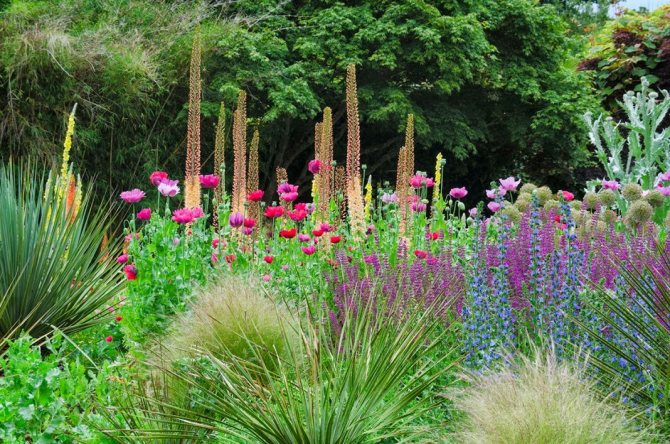

Isabella's Eremurus 'Spring Valley Hybrids' (Eremurus x isabellinus ‘Spring Valley Hybrids’).
Species plants today are almost superseded by varietal Eremurus. They are often referred to as garden hybrids or simply garden beetles. These are bright, crossed varieties with much more interesting inflorescence colors. Dazzling yellow, orange, brown, pink, juicy fruit shades of colors and various variations of dark veins, strokes and spots make the inflorescences of hybrid Eremurus inimitable. At the same time, the representation of hybrids is very diverse.
The most popular selections are hybrids. Eremurus Isabella (or as it is often called, Eremurus x isabellinus), also known as Shelford Hybrids. Despite the controversy over the classification of the plant, these varieties are one of the most popular varieties of shiryash. These are one and a half meter perennials with erect dense basal rosettes of triangular keeled leaves with a unique gray-gray color. The inflorescence is one of the densest. The flowers are small, up to 1 cm in diameter, yellow-orange-pink with stunningly bright long orange anthers.
In addition to Isabella hybrids, other varieties of hybrid origin are very popular:
- varieties of the Highdown Hybrids group with brightly colored dense inflorescences of undersized or high eremurus;
- varieties of the Ruiter Hybrids group, distinguished by early flowering and acrylic colors, most often one and a half meter.
It is worth paying attention to individual plant varieties - orange-brown Eremurus variety "Cleopatra", white variety "Obelisk" with an emerald center and a vein, dazzling yellow variety "Pinocchio" with cherry stamens, salmon variety "Romance", light green variety "Odessa", two-meter golden variety "Gold", orange-melon variety "Sunset", as well as a group of undersized Eremurus "Dwarf", etc.
Characteristics of culture
Eremurus is an unusual plant, its homeland is Central and Western Asia. Bred as a culture in the 19th century, now it is popular in European countries, in the Russian Crimea, the Caucasus, Kazakhstan, Western Siberia.
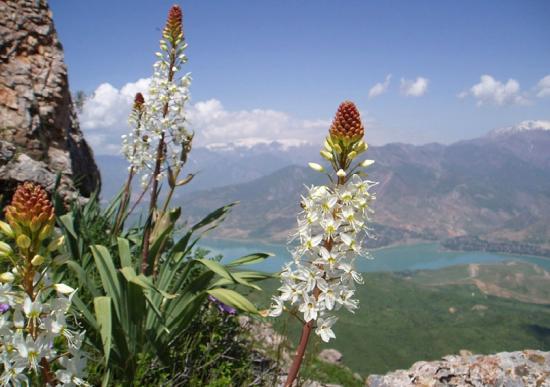

Known under other names "shiryash", "shrysh", "Tsar's crutch", "Cleopatra's needle", "Bengal fire".
This is a perennial of the genus Xantorrhea of the lily family. Experts have more than 50 varieties. The name translates as "the tail of the desert", most likely because of the peculiar shape of the inflorescences. "Bengal fire" reaches a height of 130-140 cm, has a strong, durable, straight stem.
The leaves form a basal rosette at the base, and their shape varies depending on the variety and can have an elongated, conical, cylindrical shape. The root system consists of a main rhizome and numerous branches, the rhizome looks like a starfish.
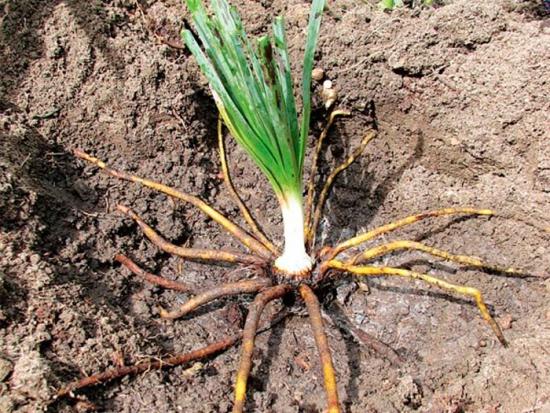

Flowers in the form of bells are arranged in a spiral on a long peduncle, from 100 to 150 cm high, the colors are different: yellow, orange, brown, white, pink, brown. After a short flowering, the seeds ripen in fleshy spherical capsules.
The use of eremurus in ornamental gardening
Eremurus are genuine garden exotic plants. And their greens, and even more so inflorescences during the flowering period, look like an exclusive decoration of any ensemble, but they are so self-sufficient that they do not need any addition, but this does not mean that they cannot be combined with other plants. Eremurus are equally good when grown alone, and when placed in a large group of different species and varieties, and when mixed with other herbaceous plants.
When choosing a place to place an eremurus, it is worth considering the possibility of digging out rhizomes, easy access to the plant for additional protection measures during the summer dormant period. Eremurus are planted in the foreground or in places that are easy to approach.
Eremurus in garden design are used:
- on alpine slides and rockeries;
- in the ceremonial flower beds;
- in mixborders;
- in flower beds and beds;
- in imitation of oriental styles and for the introduction of exotic accents;
- as vertical accents;
- for decorating flat or uninteresting compositions;
- as points of attraction of the gaze.
Large vertical lines of eremurus inflorescences look good not only on flower beds in the garden, but also in bouquets. Spectacular inflorescences are suitable for both the simplest arrangements and stylish floral arrangements. Eremurus sultans are good both fresh and in winter bouquets.
Eremurus are valuable melliferous crops that can be introduced into special flower beds or used to attract beneficial insects to the garden.
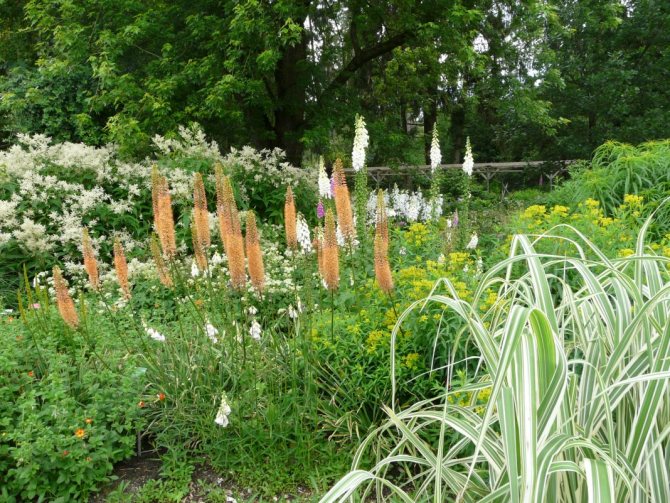

Eremurus varieties of the Ruiter group "Cleopatra" (Eremurus Ruiter Hybrids ‘Cleopatra’). <>
Shiryash in landscape design
Blooming shiryash is a real find for landscape designers. A variety of colors of inflorescences-brushes, planted in group compositions, look fabulously beautiful and pleasing to the eye. Delicate fluffy panicles rise majestically above other plants, ideal for the background of a flower bed. Shiryash is often used to decorate alpine slides and lawns. Bulbous plants look great next to it: daffodils, tulips, irises, as well as mallow, yucca and cereals.
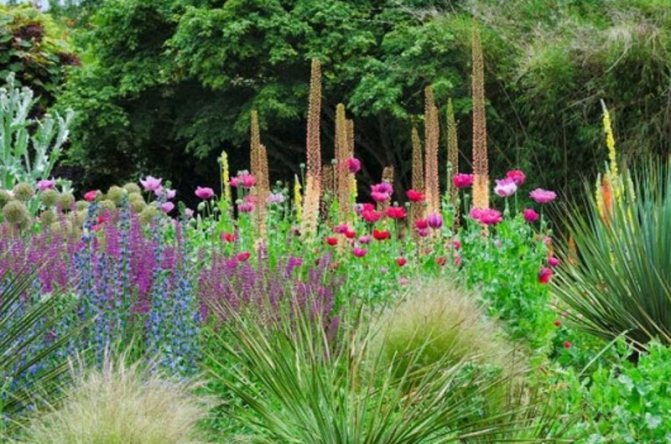

Shiryash is an unpretentious perennial that will add charm and exoticism to any summer cottage.
Selection of partners for eremurus
Eremurus is a plant original enough to stand out favorably against the background of any decorative partner. Therefore, the choice of neighboring crops for Cleopatra's needle is limited only by practical tasks and the style of the garden. Since the eremurus completely or almost completely leaves the garden scene in the summer, it is necessary for it to select partners who can mask the glades, voids, and drying leaves. Usually, Eremurus are combined with perennial stars, which come to the fore only at the beginning of summer. These perennials include veronica, monarda, garden geraniums, sage, daylilies, coreopsis.
When looking for plants that complement and set off the beauty of the Eremurus themselves, the choice is always made from the most spectacular bulbous, tuberous and textured stars. Eremurus go well with high and medium ornamental grasses, look harmoniously in addition to irises and yucca, echoing with them by the type of foliage and contrasting with their inflorescences. Daffodils, late varieties of tulips, hazel grouses, decorative bows, especially large species, will also be good partners for Eremurus. Among the flowering neighbors, it is also worth paying attention to roses and herbaceous peonies with early flowering periods, penstemones, delphiniums, astrantia, solidago.
If eremurus are dug, then the voids are usually filled with letniks, who are selected for the style and thematic design of the composition - vervains, calendula, purslane, etc.
How to grow shiryash, breeding methods
Most often, gardeners purchase a dried rhizome of a plant for planting. When buying, you should pay attention to the presence of buds located at the top of the root disk. Branched roots should not be broken off to the end, the more there are, the faster the plant will take root. There are several ways of reproduction of shiryash: by seeds and vegetatively.
Propagation of shiryash by seeds. Seedling method
The most popular method of breeding shiryash among gardeners is growing seedlings. Sowing seeds for seedlings begins in September-October. Seeds of any variety of shiryash can be bought in a store or collected on their own after flowering.
Operating procedure:
- Prepare containers, the depth of the container for seedlings should be 15-20 cm. Use universal soil, lay a drainage layer at the bottom of the container.
- Plant the seeds in the soil mixture, deepening each seed to a depth of 1-2 cm, sprinkle with earth on top. In a seedling container, planting material is stored in a dark room at a temperature of 15 degrees.
- Seedlings must be watered periodically, preventing the soil from drying out.
- The first young shoots will appear in March. It should be borne in mind that not all seeds germinate in the first year, some of the seeds you planted may only germinate the next year.
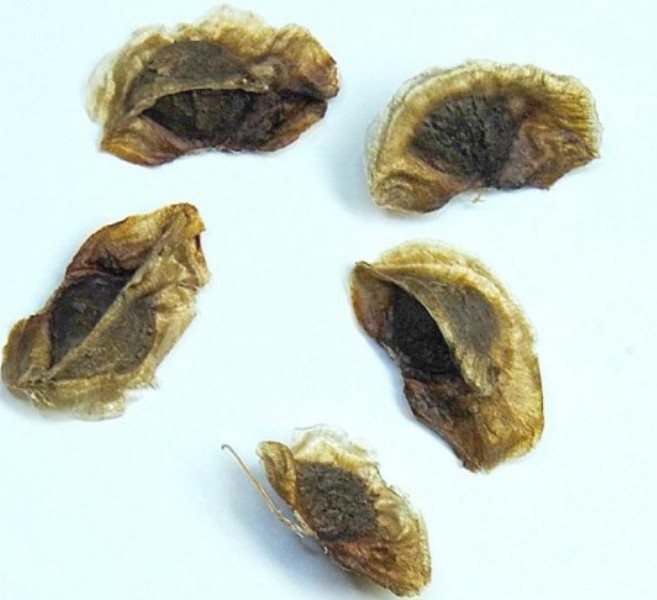

Vegetative breeding method of shiryash
This breeding method is used by those growers who already grow shiryash in their summer cottages.In March, having carefully examined the plant, you can find several new rosettes at its base. They can be separated and transplanted to another location. Separating the children, the root should not be damaged, and the incisions should be treated with an ash solution. Daughter bushes are buried in the ground and looked after like an adult plant. However, vegetative reproduction can only be used once every five years.
Conditions Needed by Eremurus
Eremurus is rightfully considered a capricious plant. The natural conditions for plant growth are so difficult to recreate in regions with harsh winters that it is easier to make a mistake in growing Eremurus than to do everything right. The plant is rightly recommended for experienced florists. But nevertheless, with a careful selection of conditions, soil characteristics, good care and high-quality preparation for winter, Eremurus not only survive, but will also delight with luxurious flowering even in the middle lane. In the southern regions, eremurus is one of the most unpretentious plants.
The capriciousness of the Eremurus manifests itself in the requirements for lighting, and for soils, and even in the choice of location. Eremurus do not tolerate drafts and winds, they are planted only in the warmest and most protected areas of the garden with minimal risk of stagnant water or dampness. The flower stalks of the plant are very stable, but eremurus are sensitive to temperature extremes, prefer to grow in warm and warm areas, which is practically impossible in a windy environment.
Lighting should be as bright as possible. South-facing sites are considered the ideal environment for the Eremurus. Even the slightest shading will not only lead to a lack of full flowering, but also an increase in the chance of plant loss due to the spread of diseases. Of course, certain species - such as the powerful eremurus, lactic-flowered and Echison, can bloom with light shading, but it is better not to experiment with reducing lighting in regions with harsh winters.
In nature, Eremurus grow in a variety of conditions, but in the garden their requirements are strikingly similar. For eremurus, only high-quality, nutritious garden soil worked out to a great depth is suitable. Plants can take root on poor soil, but in this case flowering will suffer, and growth will be slowed down. First of all, it is worth analyzing the risks of waterlogging, choosing the driest areas for the wider. The soil must contain a large amount of organic matter, but eremurus can grow on the poorest, stony soil. The preferred reaction is neutral or slightly alkaline. Even in a slightly acidic substrate, Eremurus will not be able to grow.
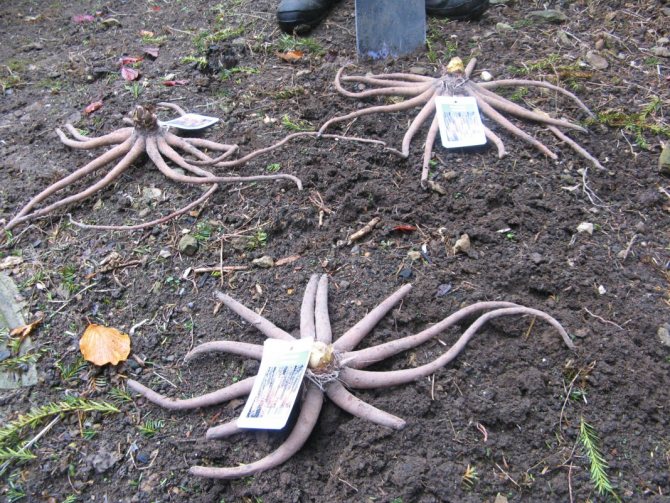

Choosing a site for planting eremurus
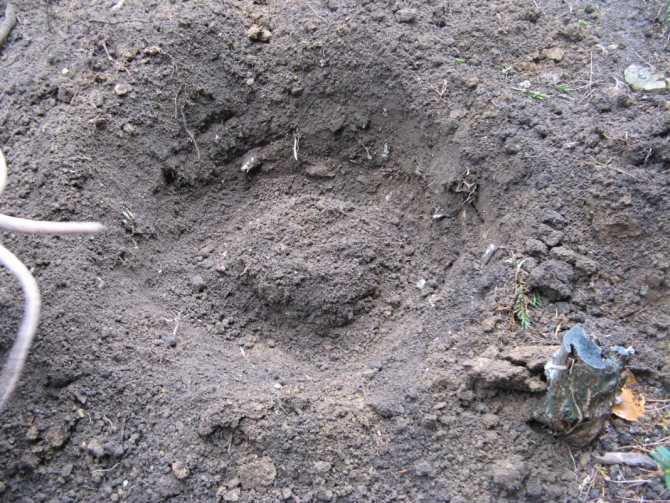

Preparing the landing pit for the eremurus
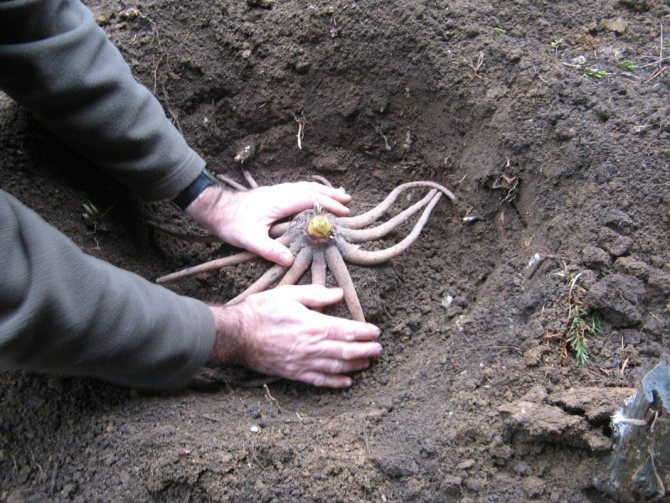

Planting an eremurus
Shiryash: growing conditions at their summer cottage
Shiryash refers to crops that are not picky to care for, but there are still certain requirements for the soil and illumination for their growth:
- Since this is a light-loving culture, for planting it, you should choose sunny, without shading, areas of the garden or summer cottage.
- The stems of a tall plant are strong and strong, they are not afraid of even strong gusts of wind.
- The plant does not need special watering, but stagnation of moisture in the soil and groundwater are destructive for it.
- The soil for planting shiryash is suitable for any acidity. The ideal soil composition is peat and loam. The main requirement for the soil is good water permeability and drainage, so that moisture does not stagnate around the rhizome, which can lead to fungal diseases.
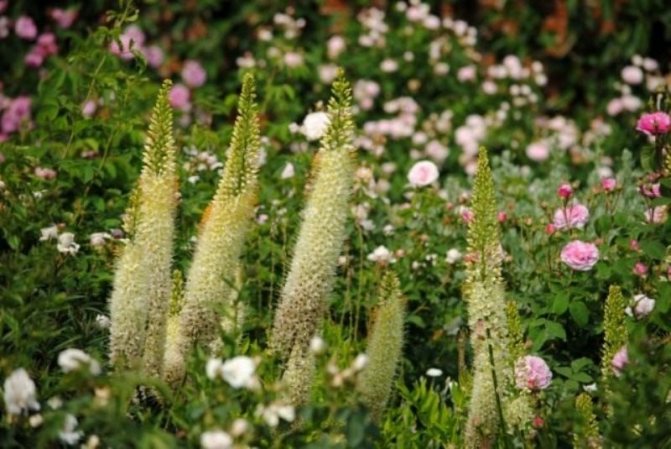

Planting an eremurus
Even in ordinary areas of the garden, it is advisable to lay a high drainage layer for eremurus. Only on rocky hills or in rockeries can you do without this measure, but usually Eremurus is always planted with a drainage layer of pebbles or gravel with a height of 20 to 40 cm. sand and small pebbles.
Eremurus are planted in the fall, in September-October (before the onset of regular night frosts).
The optimal distance for planting eremurus is from 25 cm for small species to 40 cm for large eremurus.
Plants are placed in individual planting holes about 15 cm wide and deep. When handling the Cornedonians, care must be taken not to break off or damage even small roots, and the roots themselves are evenly distributed around the perimeter of the planting hole. The Cornedonians are installed evenly, laying on an earthen mound so that the buds are at a depth of 5-7 cm. If the planting is not carried out on rock gardens, then it is better to put the Cornedonians on the sand and sprinkle the plants on top with it. The soil is poured and tamped carefully, trying to fill the voids, but not damage the roots and buds.
Growing eremurus from seeds
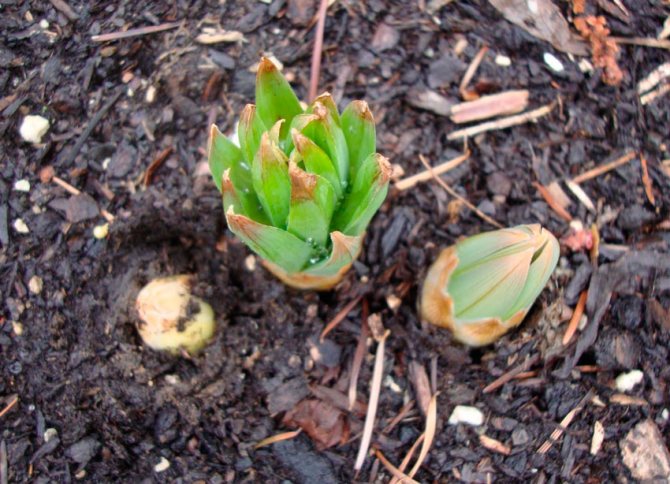

Sowing
Sowing seeds in open soil is carried out at the beginning of the spring period. When seedlings appear, they will need to be planted, while a distance of 0.3 to 0.6 m should be kept between the bushes. However, experienced gardeners recommend growing eremurus through seedlings.
Seedling
Sowing seeds for seedlings should be carried out in September – October. A container for seedlings should be chosen one that has a depth of at least 12 centimeters. The seeds must be buried 10-15 mm, while the container for germination is placed in a cool (about 15 degrees) place. In early spring, seedlings should appear, however, not all seeds can sprout, but all because some of them can germinate up to two years. Seedlings should be watered more often than adult plants, after the leaf plates have withered, a dormant period begins, and at this time it is recommended to rearrange the eremurus in a dark room. When September or October comes, the plant will need to be transplanted into individual pots, which are taken out into the street. After the frosts begin, the taken out seedlings will need to be covered with compost, foliage or spruce branches, while it should be borne in mind that the layer should not be thinner than 20 centimeters. The shelter is cleaned in spring, when it will be warm enough outside. Thus, seedlings are grown for 3 years. After that, you should plant the Kornedonts in open soil. After the aerial part of them grows, the bushes will need to be taken care of in the same way as for adult specimens.
Eremurus care
This plant is sensitive to waterlogging and is resistant to droughts, so watering can be safely excluded from the eremurus care program. If prolonged droughts and very high temperatures coincide with a period of active growth and flowering, then the plant can be watered occasionally to prolong flowering, but this is not necessary.
During the summer resting phase, when grown on alpine slides, in rockeries, on hills, problems with eremurus do not arise. On ordinary flower beds, or in the absence of guarantees of plant protection from excessive moisture, Eremurus need to create special conditions - digging up the soil around the roots after the leaves begin to wither or the construction of dry shelters, alpine greenhouses, etc. But it is much safer to dig up the plants until mid-August, after the leaves have dried (if the foliage remains partially green, then with leaves), dry the Cornedonian and store the roots of the Eremurus in a warm, ventilated and dark room. The Cornedonians should spend at least three weeks at rest. Peduncle, remnants of roots and dried leaves are cut off just before planting.
Eremurus are afraid of an excess of nitrogen, but it is impossible to achieve active growth and development without regular feeding. Top dressing for this plant is applied quite specifically:
- The first feeding is carried out before winter, using a twice reduced dose of superphosphate - about 30-40 g per square meter.
- The second top dressing is applied in early spring, using a standard (50-60 g) portion of complete mineral fertilizers and supplementing the mineral dressing with mulch or organic soil.
- The third dressing is applied at the budding stage or at the very beginning of the blooming of flowers. It is not required, before flowering, only Eremurus growing on poor soils are fed.
Loosening the soil after irrigation or precipitation allows you to maintain a comfortable soil permeability. Loosening can be combined with weeding. Eremurus responds well to soil mulching.
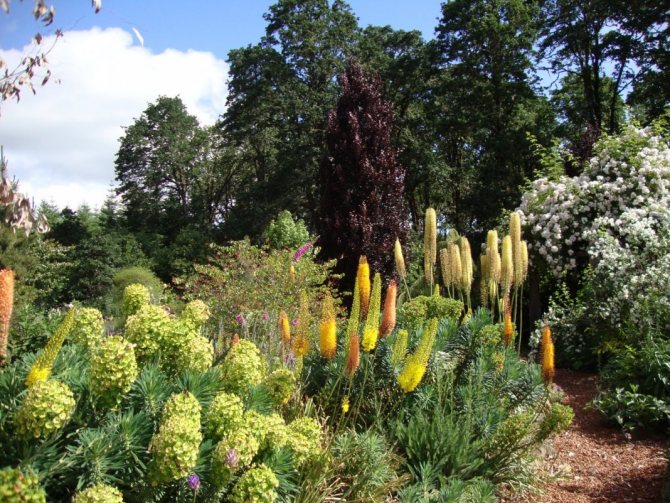

Eremurus in a flower garden
Transplanting a culture into the ground
You can see how the eremurus flower is planted, and how to further organize its care in numerous photos on the Internet. Young plants are planted in the open field in a permanent place in accordance with varietal characteristics.
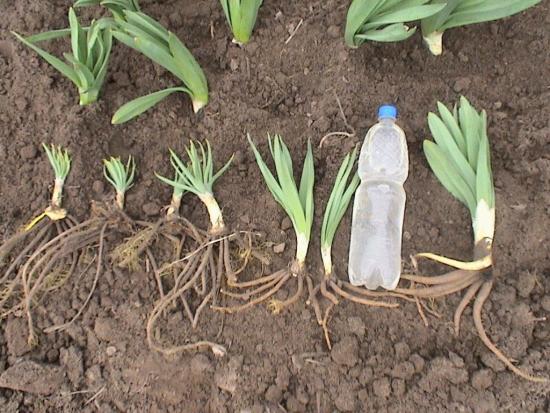

First of all, planting requires Himalayan, Yellow, Albert, Echison, Powerful. Then - Revel, Red, Red.
The best time to move seedlings is September, during which time it will have time to take root, get stronger and be well prepared for the beginning of the growing season in spring.
First, you need to prepare a milking landing site. "Shrysh" loves breathable, well-drained soil, and if your flower beds do not have such qualities, it is worth adding pebbles or gravel to the soil.
The place should be spacious, well lit, flowers in the sunlight are much brighter and larger than their counterparts grown in a shaded area. If in the area there are often strong winds, they make supports near the bushes. Tall "sparklers" are planted in the backyard of flower beds or inside flower beds.
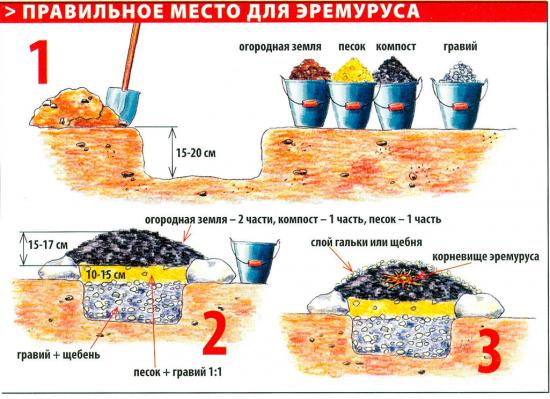

A layer of nutrient soil mixture of about 45-50 cm is laid on a layer with large particles (drainage). The best soil for the growth and development of bushes will be slightly alkaline and neutral. It includes sod land, humus, coarse river sand, wood ash and pebbles.
The soil mixture is well fertilized with rotted compost.
For each sprout, a hole is made 30 cm deep, very carefully they take out the seedlings without damaging the root system along with a lump of earth. Place the "Cleopatra's needle" in the hole, gently straighten the roots and cover the free space with soil so that there are no voids left.
You need to try to maintain a distance of 45 cm between the planting pits, and do the row spacing within 60 cm, so that in the future the bushes do not shade each other and do not interfere with growth. Then the transplanted plant is watered abundantly.
Wintering Eremurus
Eremurus need protection for the winter, but not only from frost. This plant is very afraid not so much of severe winter cold as of dampness and damage from spring frosts. The thing is that Eremurus start to grow as soon as the temperature rises a little, and suffer greatly from recurrent frost. Pre-winter protection, which is created only in late autumn, after a steady drop in temperature below zero, but before heavy snowfalls, it must protect the rhizomes from excess moisture, and the leaves and peduncles from spring frosts. Eremurus are covered with a high layer of mulch and a hillock or a thick wrapping layer of dry leaves, pine needles, peat or spruce branches. Obligatory shelter in the form of mulch with a layer of about 10 cm as protection from frost will be needed only for the most thermophilic Eremurus - Albert, Olga, Bukhara, yellow, as well as non-acclimatized varieties.
Unlike many other tuberous and bulbous crops, Eremurus does not like digging for the winter. Plants cannot be stored even in the cool in the sand, because the buds begin to develop too early and are depleted. Therefore, it is better to buy eremurus rhizomes only when they can soon be planted in the soil - in summer and autumn.
Shiryash: landing
- The time for planting shiryash is September, regardless of whether you bought planting material or grew from seedlings.
- Before planting the shiryash, you need to take care of good drainage, which will not allow moisture to stagnate and will provide air permeability to the rhizome. For the drainage layer, gravel, crushed stone, pebbles are suitable.
- A layer of soil 30 cm high is laid on the drainage layer. Any composition of the soil mixture is allowed, but the best option would be to use 1/3 of the sod land and part of the compost mixed with pebbles or coarse river sand.
- A pit is prepared for planting and a rhizome is placed in it, carefully spreading the roots horizontally, or a bush is placed along with an earthen lump using the transshipment method. Sprinkle earth on top of the landing.
- The distance between the planted shoots of the shiryash should be from 30 to 50 cm. After planting, the seedlings need to be watered. The first flowering can be expected only for 4-5 years of culture life.
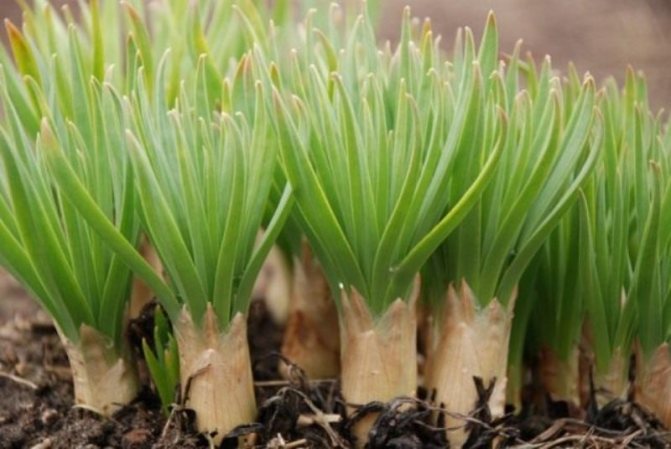

Pest and disease control
Eremurus in regions with severe winters are quite capricious. They suffer from waterlogging, manifested in growth arrest and chlorosis, viral diseases, rust, but are resistant to pests. At the slightest sign of decay or damage to the bulbs, the eremurus must be dug out, removing the damaged tissue and processing the sections. In case of rust damage, the plant is treated with fungicides. If pale yellow marks and uneven, lumpy spots appear on the leaves, indicating viruses, these specimens are best destroyed.
Eremurus love vole mice, and moles often feast on the Cornedonians, so it is better to take timely measures to combat rodents, and in winter to trample snow around the plantings.
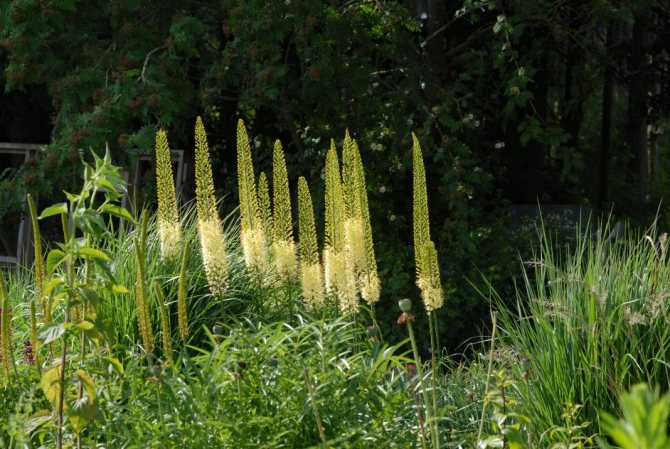

Eremurus in landscape design
Diseases and pests
Like all garden plants, Eremurus is susceptible to disease and pest attacks. This flower affects not only aphids and thrips, but also slugs, moles and field mice.
It is not difficult to deal with aphids and thrips, it is enough to carefully treat the bushes with a special solution. But as for slugs, then everything is much more complicated. They must be collected from bushes, or made from dark beer as bait, and then destroyed in order to prevent a second attack.
Moles and mice damage the roots. The root system can rot and the entire plant will die. It is difficult to deal with such neighbors. You just need to closely monitor the plant, if there are suspicions that its roots are damaged, you need to dig them out, remove the anger and treat it with ash. After the roots are dry, they must be planted back.
As for diseases, the eremurus affects both fungal and viral infections. Fungal diseases such as rust and chlorosis immediately appear on the leaves. It is necessary to start treatment as soon as the first signs appear. If the plant is infected with a fungal disease, fungicides will help to cure it: Topaz, Fitosporin, Barrier and other similar agents.
If the plant is sick with a viral disease, then it will be impossible to cure it. There is only one way out: remove the infected bush as soon as possible and burn it to prevent infection of other trees, plants and flowers.
Reproduction of eremurus
This perennial is considered difficult to reproduce, and this is often the reason for the very high cost of planting material, but in fact, shiryashi are not at all capricious in terms of reproduction of culture. Eremurus can be independently obtained from seeds or by vegetative methods.
The easiest way is to separate the adult Eremurus. Near the main rosettes of the plant, small rosettes constantly appear (usually from one to 3 annually), which signals the division of the Cornedonian and the formation of daughter ones, which have their own bottoms and roots of the buds. In the absence of division for many years, the plants thicken and bloom worse, but daughter plants should not be separated annually either.Usually, the ability to separate new eremurus from the mother bush is checked by whether the connection lines break (if light pressure does not lead to separation, then it is not worth separating the babies for at least another year). The separation and rejuvenation procedure is recommended to be carried out with a minimum frequency of 5-7 years, because otherwise the eremurus become smaller and grow over. With good conditions and care, division can be carried out much more often. The plots are carefully separated, the sections are processed and dried, if desired, they are etched with a solution of fungicides. Delenki are planted shallowly, in shallow planting pits about 10 cm deep.
An alternative method of vegetative propagation is to stimulate the separation of the Cornedonian by cutting. In strong and adult Eremurus, the bottom of the Cornedonian is slightly incised and incised, as if "marking" parts with several roots in each. After the cuts are treated with charcoal and dried, the plant is planted in a permanent place. By the next year, each "artificial division" forms its roots and buds, then the plants can be divided and transplanted, and in the second or third year the eremurus will fully bloom.
The seed reproduction method is quite simple, the plants bear fruit abundantly, but due to cross-pollination it is very difficult to predict the characteristics of the offspring. When self-collecting seeds, they are collected only from the lower part of the inflorescences, previously reducing the cylinders by one third to improve the seed formation process. For Eremurus, they do not winter, but autumn, September or October sowing of seeds. Sowing is best done in greenhouses or boxes rather than open beds. Seeds are sown in grooves about 1 cm deep. Eremurus do not germinate at the same time - some for the next year, and some of the seeds - after two or three years. In the spring, seedlings develop quickly enough, they are grown, providing regular care, stable light moisture, protection from weeds and soil compaction. They continue to grow in boxes until the leaves wither, after which they are carried away to a dark and dry room without digging. In the fall, crops are placed in the garden, in the first winter they are covered with a high layer of mulch made from compost, leaves and spruce branches. Plants are grown in boxes until the third year, when the Cornedonian can be planted in open ground. Eremurus obtained from seeds will be able to bloom in regions with severe winters only 5-7 years after sowing.
Features of eremurus
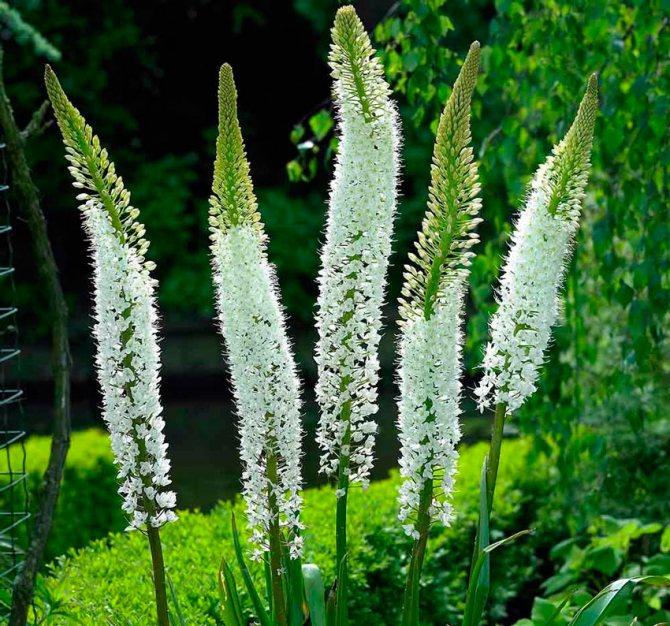

Eremurus has a root that looks like a starfish. The diameter of the Cornedonian varies from 10 to 15 centimeters, and its shape is disc-shaped, twisted fleshy roots that are cylindrically or spindle-shaped thickened from it, while they stick out in different directions. On the bush, most often there is a large number of flat trihedral-linear leaf plates, which can be narrow or wide, their lower surface is keeled. A large elongated cyst-shaped inflorescence of a meter length is located on a single leafless shoot. Bell-shaped flowers on the peduncle are arranged in a spiral, while they can be colored yellow, brown, dusty red or pink. Flowers begin to open from the bottom of the inflorescence, with each flower withering approximately 24 hours after blooming. The duration of flowering directly depends on the type and variety of the plant and can vary from 10 to 40 days. The fruit is a three-celled semi-lignified or membranous capsule of almost spherical shape, which cracks when ripe, its surface can be wrinkled or smooth. Triangular wrinkled seeds have 1 transparent wing. Such a flower is a very good honey plant.
Care
For the rapid development of culture and the reduction of diseases, it is necessary to observe proper care of the seedling.
Watering
The plant needs to be watered abundantly every 2-3 days until July, but if it rains regularly, irrigation is reduced.After the plant releases buds, watering is reduced to once every 6-7 days.
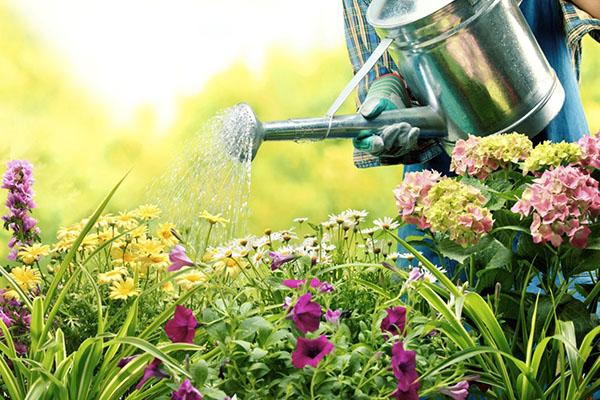

Top dressing
Top dressing is carried out according to the following scheme:
- compost is introduced in the spring;
- in the middle of summer, phosphorus and potassium are introduced before flowering;
- in the fall, it is necessary to add superphosphate and humus.
If there is poor development of the plant, it is necessary to additionally apply complex fertilizers.
Loosening and weeding
It is recommended to remove weeds manually in order to reduce the risk of root damage. Loosening of the soil is carried out regularly before watering. This is necessary to reduce disease and oxygenate the soil.
Storage during rainy periods
Prolonged rains lead to damage to the root of the plant, in order to avoid such a problem, the following tips must be followed:
- loosen the soil regularly so that there is no risk of root rot formation;
- install a drainage system;
- huddle plants so that the liquid can drain.
However, in cases where there is a prolonged rainy summer, it is necessary to carefully dig up the culture and store it in a dry place.
See also
How to get rid of midges in indoor flowers using chemical and folk remediesRead
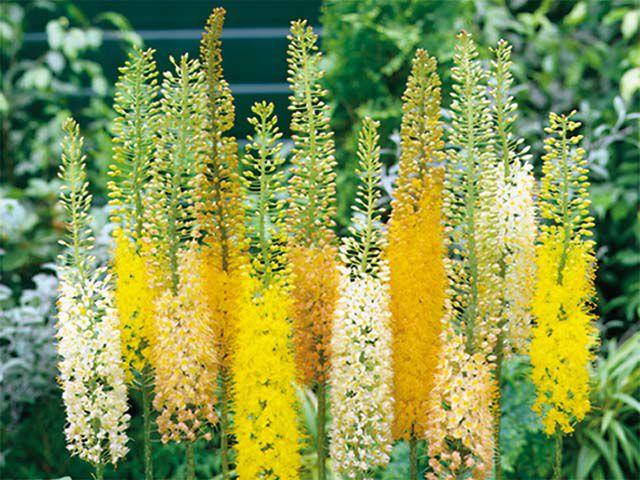

How to properly care for a perennial?
Planting and caring for an eremurus flower requires adherence to some agrotechnical techniques when leaving:
Watering is necessary often, but not too abundant. It is especially important during dry periods and during flowering. But during prolonged rains or after flowering, watering should be reduced.
The perennial responds gratefully to systematic feeding. In the fall, the best option would be to choose superphosphates. 35 g of the mixture is applied to 1 square meter of soil. In the spring, before waking up, additional fertilizing with standard complex fertilizers for flowering "desert tails" is required at the rate of 60 g per 1 sq. M.
For abundant flowering in the bud setting phase, plant breeders apply nitrogen fertilizers under the root.
During the entire growing season, the soil around the bush is loosened, weeds are removed. This must be done with care so as not to damage the rhizome.
Dried branches are cut off, yellow leaves and faded buds are removed.
Varieties that are unstable to low temperatures are carefully sheltered from frost. It can be peat, spruce branches, foliage or manure in a wide layer of 15 cm. And in the first months of spring, the "insulation" is removed. Mulching helps keep the roots from frost. And in order to protect themselves from rodents, wormwood branches are laid around the bushes and fixed from the strong wind with stones to the ground.
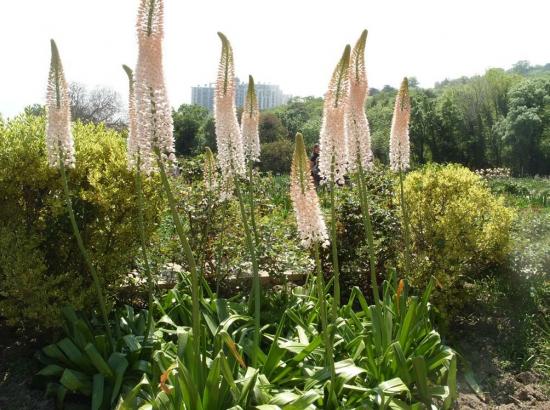

How to grow eremurus, the secrets of proper care
In nature, Eremurus chooses sandy, steppe and clayey areas, so it can hardly be called a particularly whimsical plant, but some points are still worth considering.
The best time for planting eremurus is the beginning of autumn, the place should be sunny and calm, and the soil is moderately fertile and non-acidic, although Altai and lactic-flowered eremurus grow well even on slightly loosened clay. What all species cannot tolerate is the high level of groundwater. Therefore, in damp areas, it is appropriate to build raised flower beds.
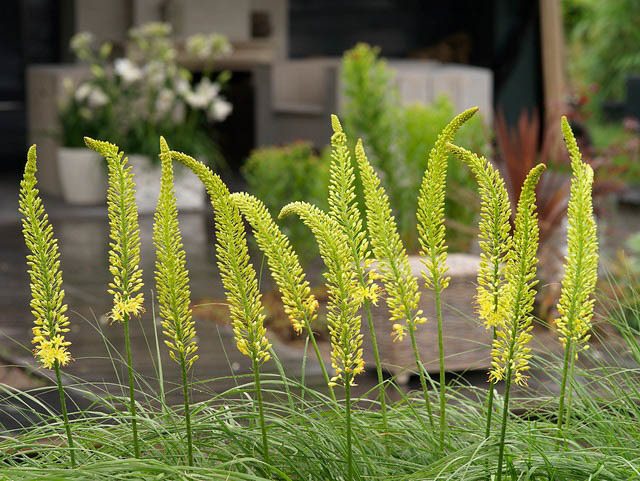

The place for the eremurus is prepared in advance, the point is not in the hole itself, but in the preparation of high-quality drainage, in which we will describe its importance below. The size of the hole is adjusted to fit the planting material, all roots must be completely straightened. The depth of the fossa is calculated according to the size of the Cornedonian, its top can rise above the ground by at least and no more than 10 cm.Each plant is planted at a distance of 30 to 60 cm from each other, rely on the height of the flower - each bush needs light. Before planting the rhizome, place it in a light solution of potassium permanganate for 2 hours.
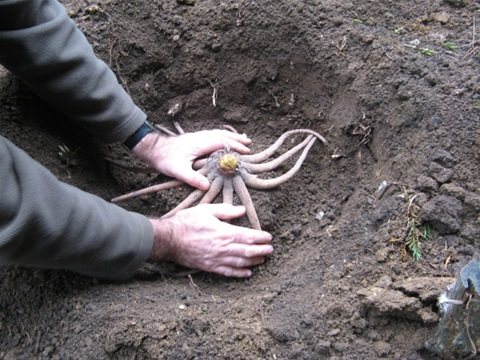

About drainage
At rest, the rhizome needs to dry thoroughly, if the Altai or Crimean eremurus can have enough of an ordinary high bed or light drainage, then other species need additional protection from excessive moisture in the soil. Subject to solo planting over the bushes, you can build a small umbrella or other protective structure, another option is to cover it with a film.
Some growers dig out a faded bush (it is not necessary to wait for the aboveground part to dry out), dry the root for about 3 weeks and plant it back into the soil, it cannot be stored until spring. It is worth considering that some species in the fall (after summer dormancy) actively grow roots and form a bud next year, digging up and untimely planting can lead to disruption of the rhythm and death of the plant.
Moisture is needed only at the beginning of the growing season, further frequent watering is out of the question, Eremurus survive and grow well even in a sandy desert. There is no need for excessive fertilizing either; in critical cases, fertilize the plant immediately after the spring awakening and at the end of autumn.
Diseases and pests
Mice and moles are the main enemies of the eremurus. These rodents, laying their underground paths, damage, and sometimes gnaw at the roots of the plant, which begins to rot, the bush itself becomes pale and depressed. If you find small ill-wishers, you need to dig up the eremurus, cut off the damaged parts of the root, soak it in potassium permanganate, sprinkle it with ash, dry it well and plant it back.
Another problem that can arise during cultivation is viruses. Light yellow tubercles appear on the leaves. It is advisable to remove all infected plants so that the disease does not spread.
Useful Tips
- When choosing planting material, pay attention to the fact that the root must be dried and contain several buds. If the main horizontal roots are broken off, discard the purchase, only the thin tips of the roots can be removed.
- The stems of the eremurus are quite strong, but during heavy rain the brushes are filled with water, become much heavier, bend over and break, therefore it is advisable to tie especially tall species to a support.
- For the winter, the plant can be covered with a layer (10 cm) of compost, spruce branches or peat; the shelter can be removed after recurrent frosts.
- When plants are propagated by seeds, it is better to choose boxes from the lower tiers of the peduncle.
- Excessive fertilizing with nitrogen fertilizers and manure has a bad effect on wintering and can lead to the development of diseases, for example, rust.
Features of the correct fit
Planting correctly is an important process that requires tremendous patience and attention to your plant. The further development of culture depends on it. Eremurus is a long-known plant, which began to be grown as an ornamental crop relatively recently.
Shiryash needs to pay a lot of attention when planting. It is especially important to properly handle the roots of the seedlings to avoid damage. Among the basic planting rules, many gardeners distinguish the following:
- Before planting, it is necessary to place the eremurus seedlings in a container with a solution of potassium permanganate for at least 2 hours;
- The grower should choose a well-lit area with slightly acidic or neutral soil. In addition, the place should not be blown by winds;
- Before planting the plant, it is necessary to add a drainage fertilizer to the soil, which should consist of broken brick, gravel and wood shavings;
- In addition, organic fertilizers must be added to the soil, among which gardeners prefer peat, compost and humus;
- It is important to dig a shallow hole, which will be of such a diameter that it is possible to spread all the roots of the plant;
- Each sprout must be planted at a distance of more than 0.5 meters from the other;
- When you buy the necessary seedlings for planting in the store, you need to carefully examine its roots so that they are not broken and infected with any disease.
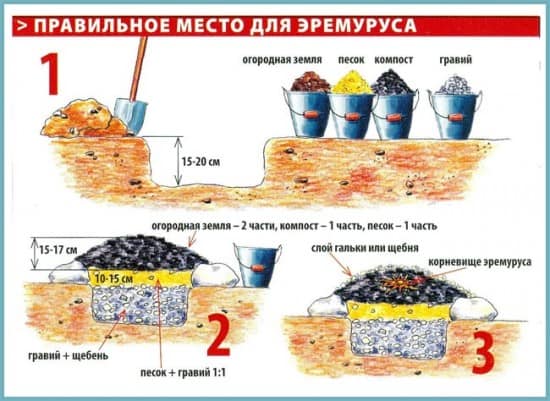

Optimal conditions
Plants of the genus Eremurus from the Asphodeloid family, belonging to the Asparagus family, need to recreate conditions as close as possible to their natural range. The ideal place for planting such flowers is open sunny areas where water never stagnates. Thanks to firmly developed roots and strong stems, the flower is not afraid of gusts of wind, so it does not need to be hidden in the shade of trees and bushes.
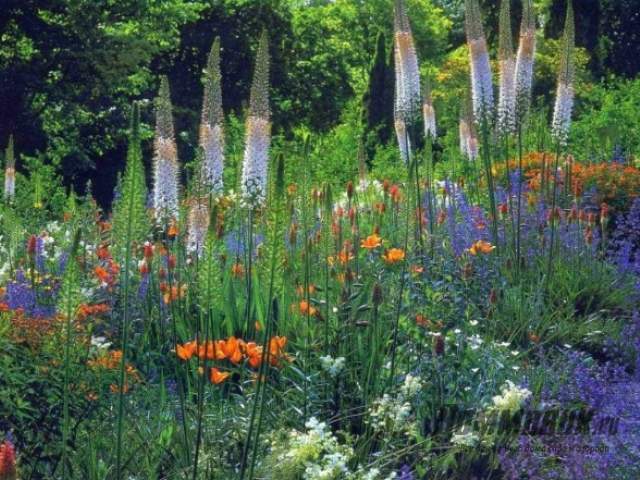

Soil for eremurus should be well-drained, with a neutral or alkaline pH. Accustomed to the Spartan conditions of deserts and plateaus, on overly nutritious and organic-rich chernozems, the roots begin to intensively accumulate minerals, due to which flowering becomes rare or stops altogether. For this reason, it is better to cover the site with fine-stony, clay or sod soil before planting, and in no case apply manure. A drainage layer should be placed at a depth of 25-30 cm in order to prevent rotting of the root system during frequent rains.
Watering plants should be carried out only in spring, when the shyryash is actively increasing the green mass. If rains pass during this period, additional moisture is not required at all. In summer, Eremurus reacts better to heat, but in the period from July to September it is desirable to provide an arid regime, covering the flower from precipitation with a kind of "tent".
Fertilizers for plants are applied before winter (30-40 grams of superphosphate per square meter) and early spring (20 grams of ammonium nitrate per square meter). The introduction of nitrogen and organic matter (humus) impairs the development of desert culture, reduces its decorative effect, and violates resistance to frost and disease.
Vegetative propagation
In addition to planting with seeds, shiryash reproduces by dividing the rhizome. This operation takes place from August to September. The Cornedonians are dug up, dried and the daughter processes are separated.
Further, the resulting parts can be planted according to the usual scheme: in well-drained soil, at a distance of 40-50 cm from each other.
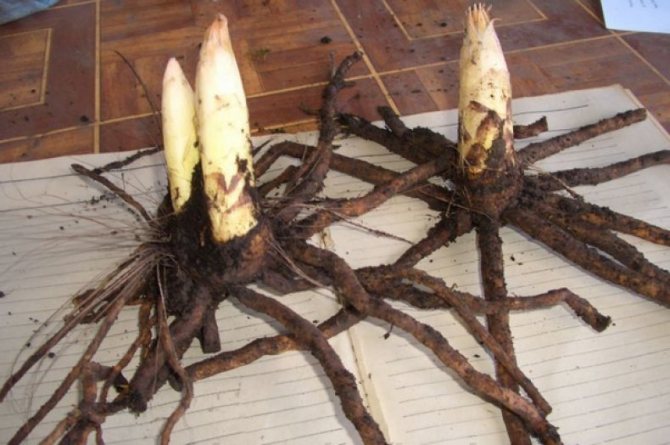

Read also: Dahlias are a beautiful autumn flower
Eremurus diseases
If pale yellow bumps appear on the plant - it was infected by a virus, in this case it is recommended to remove the plants from the garden as soon as possible in order to avoid contamination of other flowers.
Eremurus also suffers from rodents, which damage its roots and from poor drainage, which leads to their decay. Then you should dig it out, cut off the spoiled roots, treat it with manganese, sprinkle it with ash, dry it slightly and plant it again, not forgetting about all the necessary prevention methods.
Eremurus: landing in two ways
Experienced flower growers advise to plant Eremurus in early autumn, choosing a suitable place for it: open areas, abundantly warmed up by the sun. The plant does not like darkened places, so it is not recommended to plant it under trees. But it is important to take into account the influence of the wind, from which the long stems of the flower can break. If there is such a danger, it is necessary to build supports and the effect of the wind is minimized.
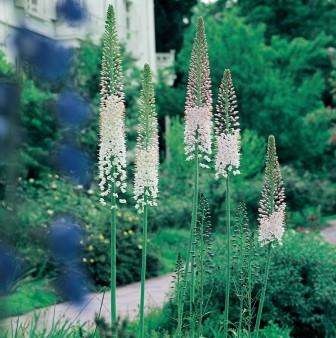

Most often, Eremurus is sold as a dried Cornedonian. When buying, a mandatory step is to check for the presence of buds, scales, which should be fresh, fleshy and tightly packed. The root system should not be broken or broken off. Often unscrupulous sellers offer dried or damaged seedlings, so it is important to be careful.
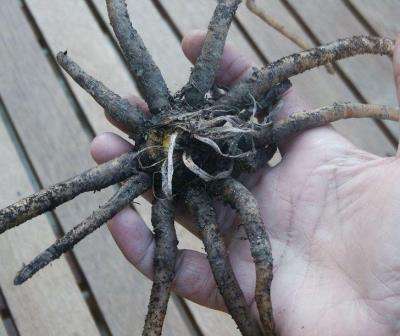

When planting, properly fill the bottom of the hole with gravel or pebbles. Such a drainage system allows moisture to leave without stagnating in the root system, otherwise it will lead to rotting. The soil should be slightly alkaline, but the best solution would be to prepare the soil with your own hands: compost, fresh turf soil and river sand.The Kornedon is buried deep into the hole and compacted tightly with earth.
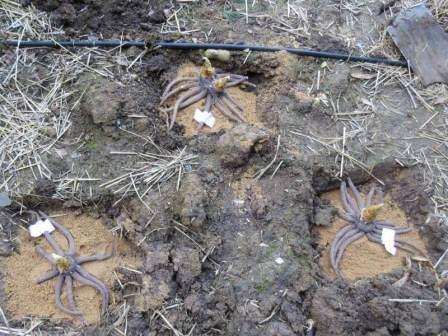

If it was not possible to buy the Cornedonians, you can find the seeds of the Eremurus, which appear in the fall, and plant them. Each seed is planted in a separate container or at least 10 cm apart. In order for the first shoots to appear, the seeds must be covered with plastic wrap, periodically watered without being carried away, and put in a warm place with a temperature of at least 15 degrees.
Description and general characteristics
Eremurus (shiryash) is a herbaceous perennial plant from Central Asia, which first received a botanical description only in 1773 thanks to the Russian scientist Pallas. The plant began to be used for decorative purposes only in the second half of the 19th century.
Prior to this, the bushes of this plant were common in Asian countries and were used for food purposes. Currently, breeders have developed many new varieties that have "spread" across the gardens of Western Europe and Russia.
Eremurus is a tall shrub that is usually more than 1.5 meters tall. It has a large root system shaped like a crab or a spider. Massive roots help plants live long without water, and help the gardener free themselves from unnecessary work.
The leaves of this plant are large, resembling the leaves of tiger lilies. Flowers usually bloom in July and grow on a high stem very close to each other.
The most common types
Eremurus differs from other plants not only in its unique appearance, but also in a large number of varieties and subspecies. This article lists only the most popular and widespread in Russia. Among these, gardeners distinguish the following:
- Eremurus Echison
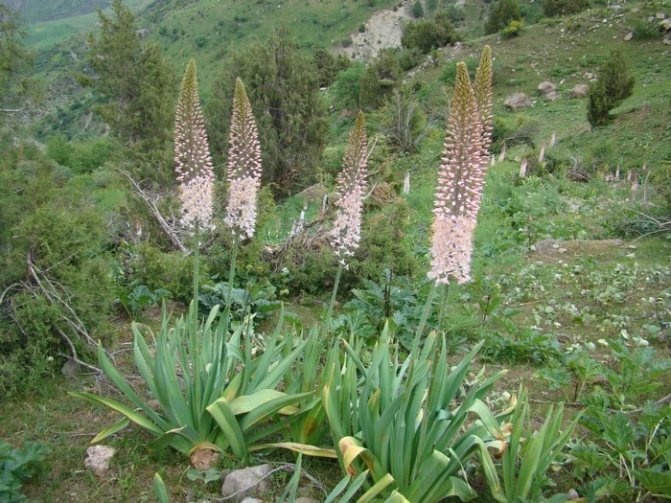

- Eremurus bunge Eremurus Olga
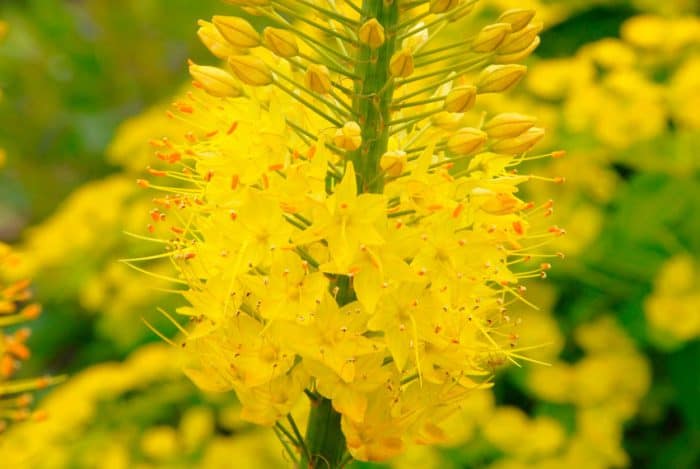

- Eremurus Albert Eremurus powerful
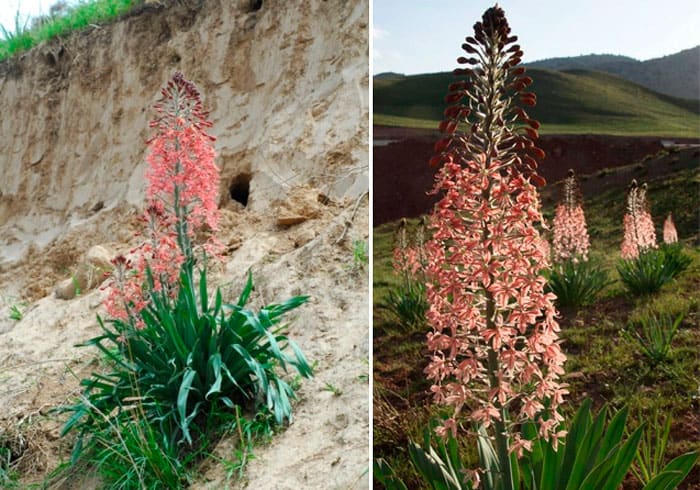

general characteristics
The ancient Greeks called the unusual flower "the tail of the desert" (from "eremos" - the desert and "ura" tail). This name is consistent with the appearance of the Eremurus with its high (100-200 cm) cone-shaped inflorescence, assembled from hundreds of miniature stars with elongated stamens. The buds begin to open gradually from bottom to top, and thus resemble holiday candles or sparklers. Shrysh bloom lasts from early June to about mid-summer, for 25-40 days.
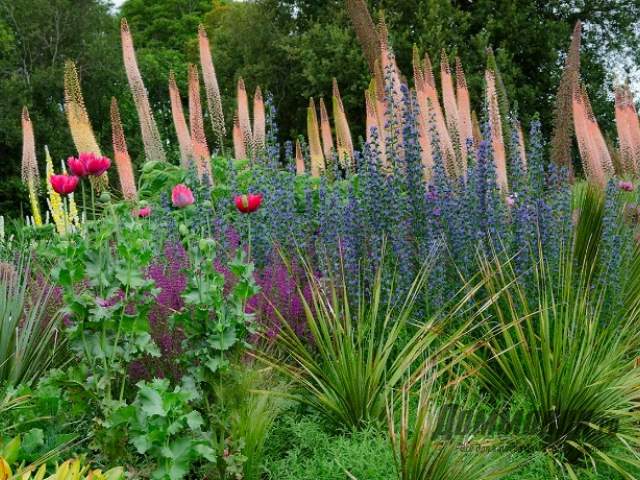

Eremurus flowers have a large palette of shades. There are sunny yellow, orange, purple, pale pink, peach, blue, white varieties. Being productive honey plants, they attract a large number of bees and produce up to 20 kg of honey per hectare.
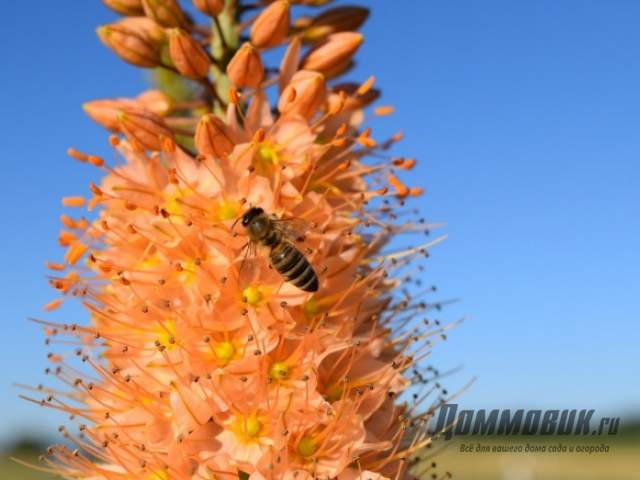

In the East, the stems of the plant have been used since ancient times for dyeing silk and woolen fabrics in yellow, pink, olive tones. For many centuries, the roots served as a source of natural glue - eremuran, which was widely used in footwear and construction. By the way, in many Asian languages the name "shryash" or "shyryash" means glue.
After flowering
After the plant has faded, it is necessary to provide it with proper care. This will help saturate the roots with essential nutrients before winter.
Collection and storage of seeds
The seed boxes are cut at the end of August and placed in a ventilated room for drying. At the end of September, the boxes are opened, the seeds are laid out on a flat surface and left for several days. Finished seeds are placed in a cloth bag and stored until they are planted in the ground.
Wintering
In October, using garden shears, the flower stems are trimmed. The roots are covered with peat or humus. A layer of fallen leaves or spruce branches is laid on top and left until spring. In winter, it is recommended to additionally use a layer of snow in places where eremurus grows.
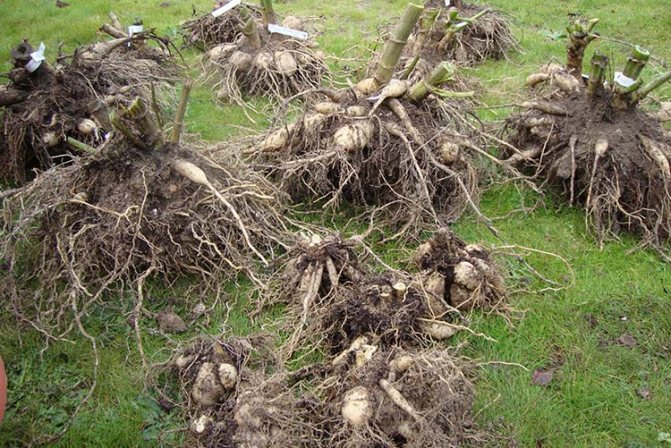

Seed collection
Quality seeds ripen only in the lower part of the peduncle. Therefore, to obtain seeds, you will have to cut off the brush by a third.
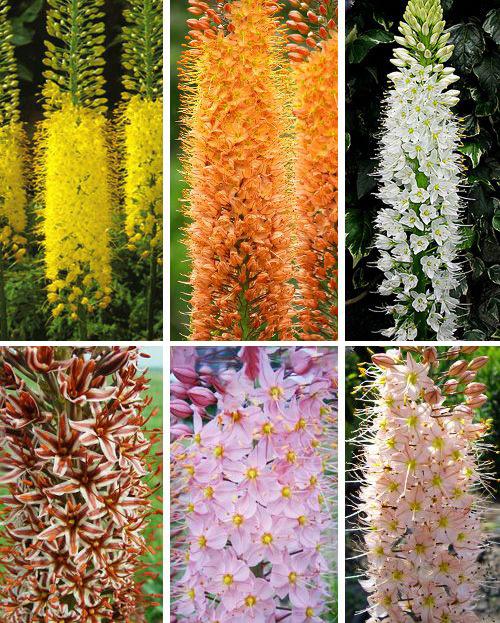

Seeds are harvested in the second half of August. To do this, you will need to cut the peduncles with a pruner and place them until fully ripe in a dry but regularly ventilated place.
Keep in mind: mature seeds are beige in color.
Closer to the beginning of November, it is necessary to release the seeds and seed pods.
How to propagate Eremurus by children
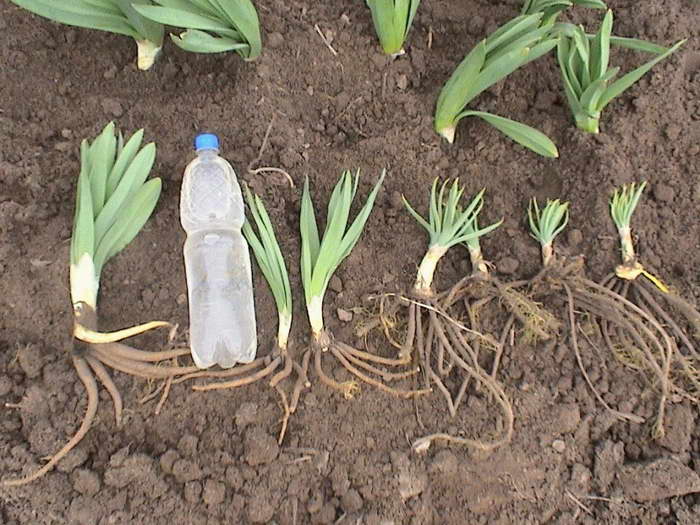

How to propagate an eremurus photo
In the spring, several small ones can be found near the main leaf outlet. Separate them from the mother plant, treat the cut with a fungicide and transplant.
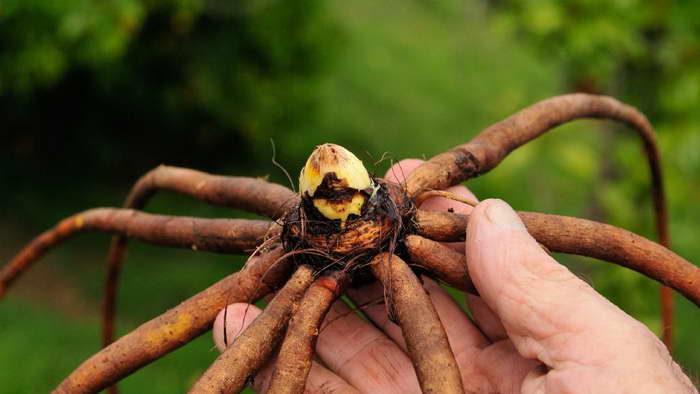

Eremurus can be cut and obtained several plants in the next season
You can speed up the process of education "kids". To do this, before planting, the Cornedonce should be cut into several parts so that each part contains several roots. Treat the cuts with a fungicide, plant in open ground. By the next fall, each part will have a scion.
Preparing eremurus for winter
Eremurus tolerates winter well, so only thermophilic species should be sheltered. Sketch over manure, peat, and spruce branches to trap the snow.
Thus, the plants winter well. Young roots should not be stored until spring. It is better to plant them immediately in the fall and cover them with peat and spruce branches.
The shelters are dismantled when the weather is warm and the plants start to grow. A tall and beautiful plant will brighten your garden without requiring much attention. In addition, such a good honey plant can also help you in the production of honey, unusual for our regions.
Seed selection
The seeds can be purchased at specialized stores or obtained by yourself. To do this, you will have to sacrifice 2-3 inflorescences. In the early stages of flowering, the upper part of the "tail" is removed by a third, for full maturation of the lower seeds, because the tip is not suitable for these purposes. As soon as it is ready, the box acquires a beige color, then the inflorescences are cut off (August) and sent to a dark place to rest and ripen. At the end of October, they are husked by hand, the seeds are sifted, laid out in cloth or paper bags.
It is worth noting that eremurus seeds have a fairly high germination rate, but this process can take several years. The seeds of this year that did not sprout for some reason may germinate the next.
Whichever method is chosen, it is better that the seeds are fresh, then the likelihood of successful sowing and growing will be higher.
Reproduction
The plant reproduces in two ways, gardeners choose the appropriate method according to individual preferences.
Generative
After the plant has faded, boxes with seeds will appear, after the seed box is fully ripe, it is necessary to collect the planting material and treat it with an antiseptic. Dry the seeds and plant in the soil.
Vegetative
Implies dividing the parent root into several parts. For this, the soil layer is carefully removed, exposing the roots. Using a sharp knife, cut the root into several pieces. Each part must have a kidney. Cutting points must be treated with charcoal.
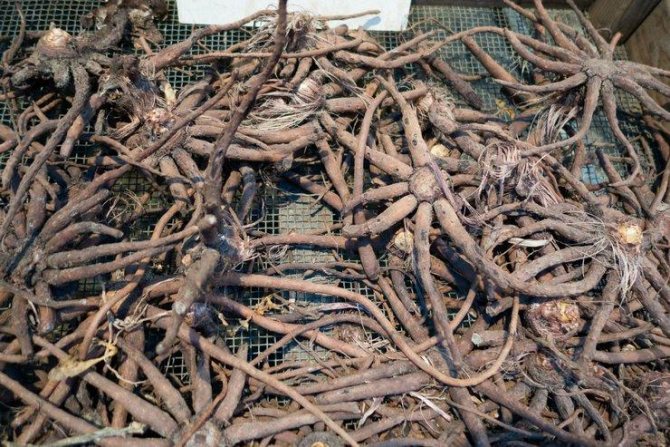

Parts of the root must be placed in a dry place and left for a month. Then plant the shoots in the ground.
Important. An adult plant can be used for propagation once every 5-6 years.
Popular varieties
Among the large list of crop varieties, the most commonly used varieties stand out.
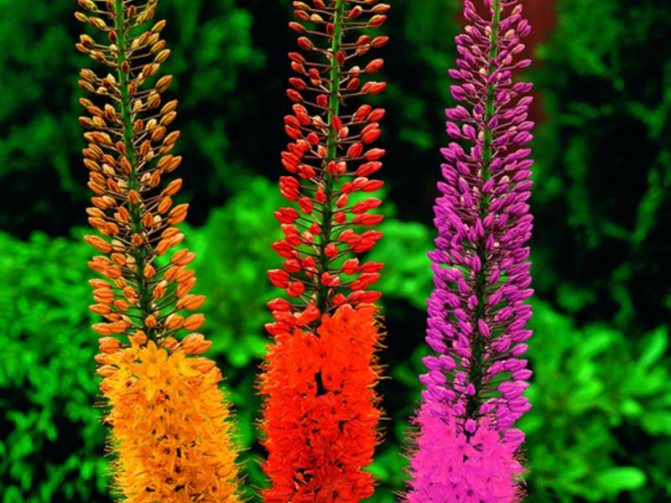

Isobel
The culture has an attractive bud color. The flowers are pink-orange and large in size. The bush grows up to 1.4 meters high.
Rosalind
A distinctive feature of the culture are the buds of a pale pink color. The bush reaches a height of up to 1.5 meters. Leaves are green with a slight bloom. Bloom most often in mid-June.
White beauty
The height of the bush is 90 cm. The flowers are white. A panicle with buds is dense, up to 40 cm long. It blooms in mid-June.
Moonlight
The plant has yellow flowers, which can reach up to 3 cm in diameter. The height of the bush is 1.3 meters.Prefers a sunny location for planting.
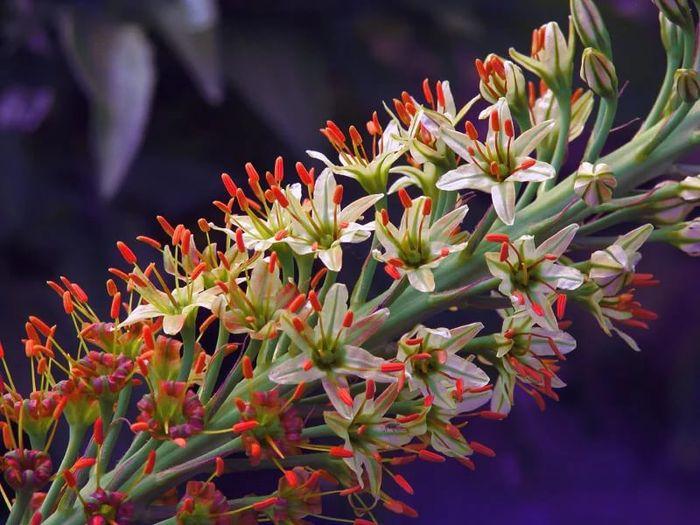

Gold
The plant is tall. The stem height can be up to 2 meters. Inflorescences are yellow with impurities of pink. The panicle is not dense, up to 70 cm long.
Citronella
The plant can be of various colors, but the most common are yellow and salmon colored. It tolerates low temperatures well. With proper care, it reaches a height of 1.2 meters.
Important. The culture does not tolerate excessive moisture. Therefore, when landing in the ground, it is necessary to avoid places with groundwater located close to the surface.
Lady Falmouth
The culture is tall. Can reach up to 1.6 meters. The brush with buds is loose, the flowers are of medium shape, cream color. Bell-shaped buds.
Sunset
The stem of the culture reaches 1.7 meters. The flowers are salmon colored with red impurities. The leaves are triangular, smooth, erect. The brush reaches a length of 80 cm.
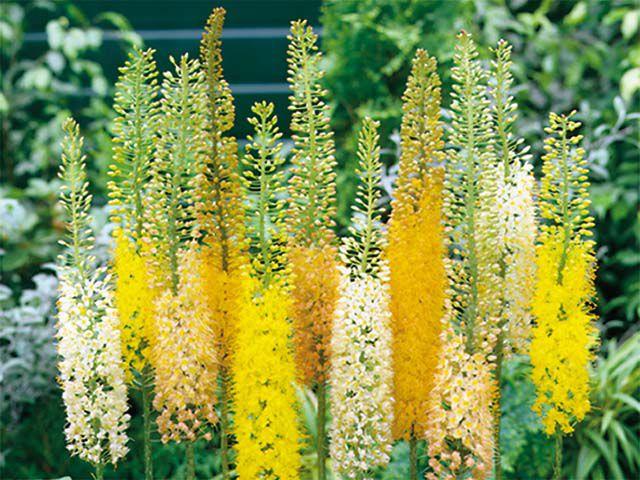

Don Dwarf
Small bush. It can reach up to 1 meter. The flowers are yellow. Panicles are parallel, bell-shaped.
Hydown Dwarf
Refers to tall, which reach a height of up to 2 meters. They can be of different shades of yellow. The brushes are dense and can reach sizes up to 90 cm. It blooms in the middle of summer.
Golden Dwarf
A distinctive feature of the flower is the bright yellow color of the buds. Stamens are longer than inflorescences. The brush is fluffy, up to 80 cm long.
Cleopatra
The plant has a vibrant coral color that attracts and stands out from other crops. The plant is 1.1 meters high.
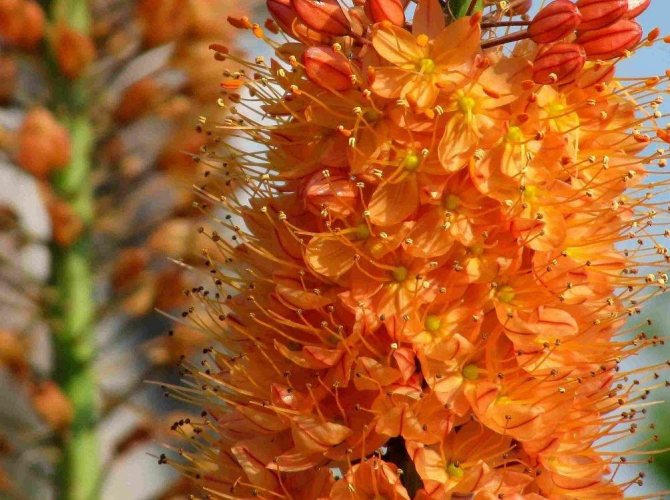

Pinocchio
The bush is 1.4 meters high. The flowers are yellow with gray impurities, the stamens stand out with a cherry tint.
Obelisk
The leaves of the plant are rectilinear, triangular. The flowers are white with a bright emerald center. It has a pleasant smell.
Romance
Plant height 1.2 meters. Blooms in mid-May, early June, depending on weather conditions. Salmon-colored buds with a pink border.
Rexon
Bush up to 1.3 meters high. The inflorescences are orange. The stem is thin, practically without leaves. Blooms in mid-June.
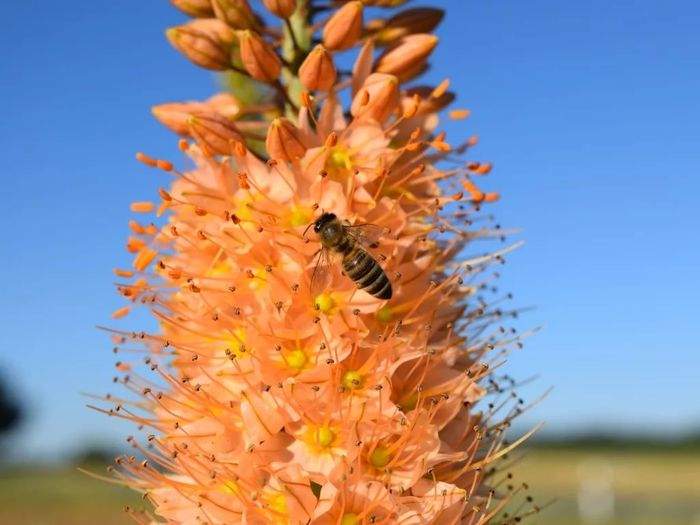

Bungei
The culture has a bright yellow color of buds with minor impurities of a golden hue. After wilting, the buds turn brown. A plant up to 1.4 meters tall can grow in the shade.
Ruteira
The culture can be of different shades: from yellow to pale pink. With proper care, it reaches a height of 1.1 meters.
Eremurus: planting and care in the open field. Photo
Any gardener wants to have in his summer cottage not only a variety of fruit trees and an abundance of vegetables, but also beautiful, fragrant flowers that will complement and decorate any country landscape. It is to such plants that the eremurus belongs - a flower that looks somewhat like a brush. Even when cut, it will stand for quite a long time. His planting and care in the open field does not require special skills, but you still have to create some conditions.
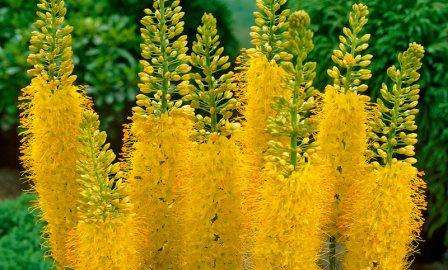

Diseases
Flowers are susceptible to pests and diseases.
| Pest | Control measures |
| Slugs | Sprinkle the soil with tobacco dust, ash, or ground chicken shells. |
| Rodents | Spread out baits, spill holes with water. |
| Aphid | Wash the flowers with soapy water. Insecticides (mixed with water):
|
The plant can be susceptible to disease.
| Symptoms | Cause and disease | Remedies |
| Brown and dark spots on leaves, plant weakness. | Dampness. | Treatment with fungicides once every 2 weeks (with water):
|
| Fungal damage. | ||
| Rust. | ||
| Mosaic of leaves. | Defeat by viruses. | It is not treated. Digging up and destroying the plant. |

